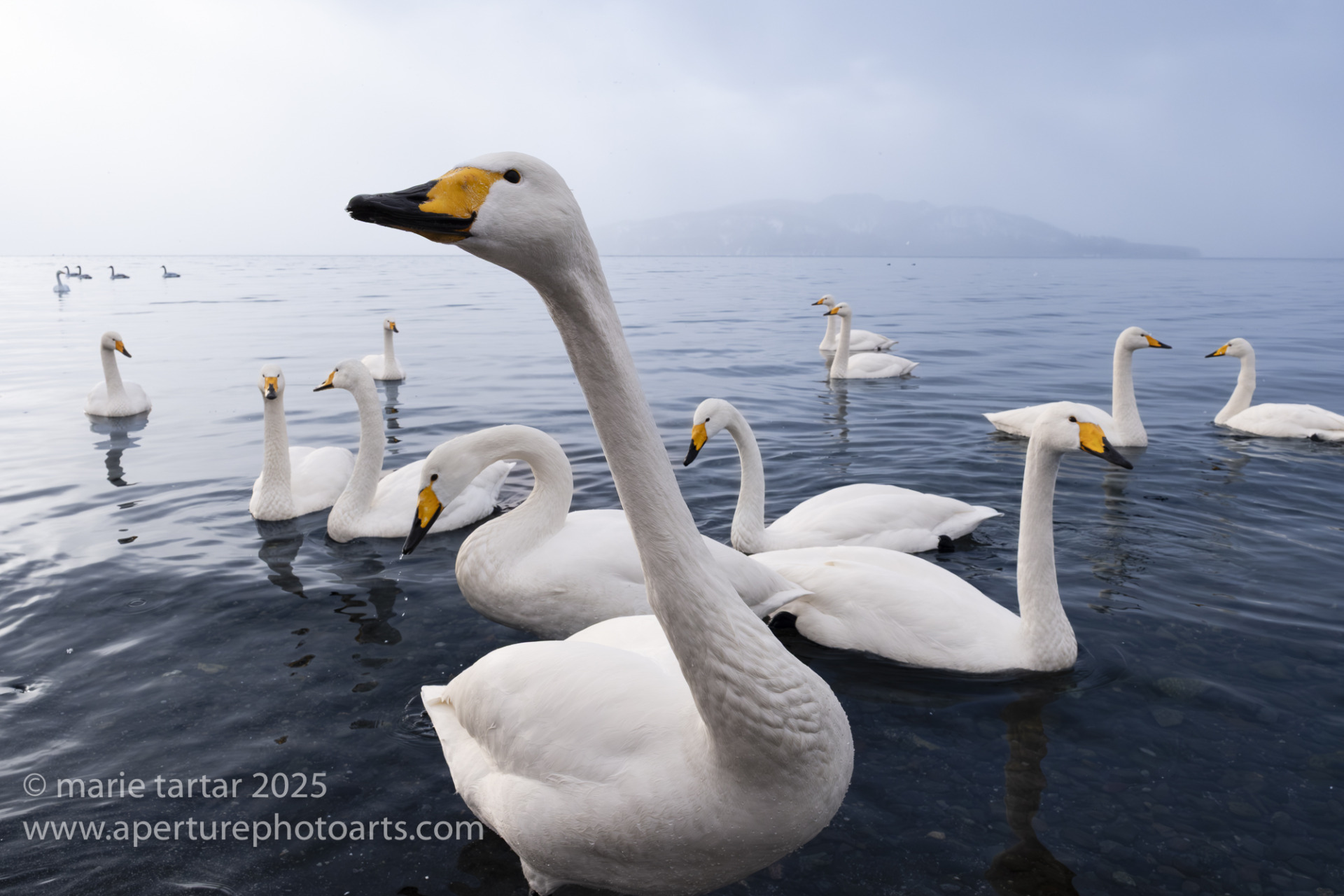
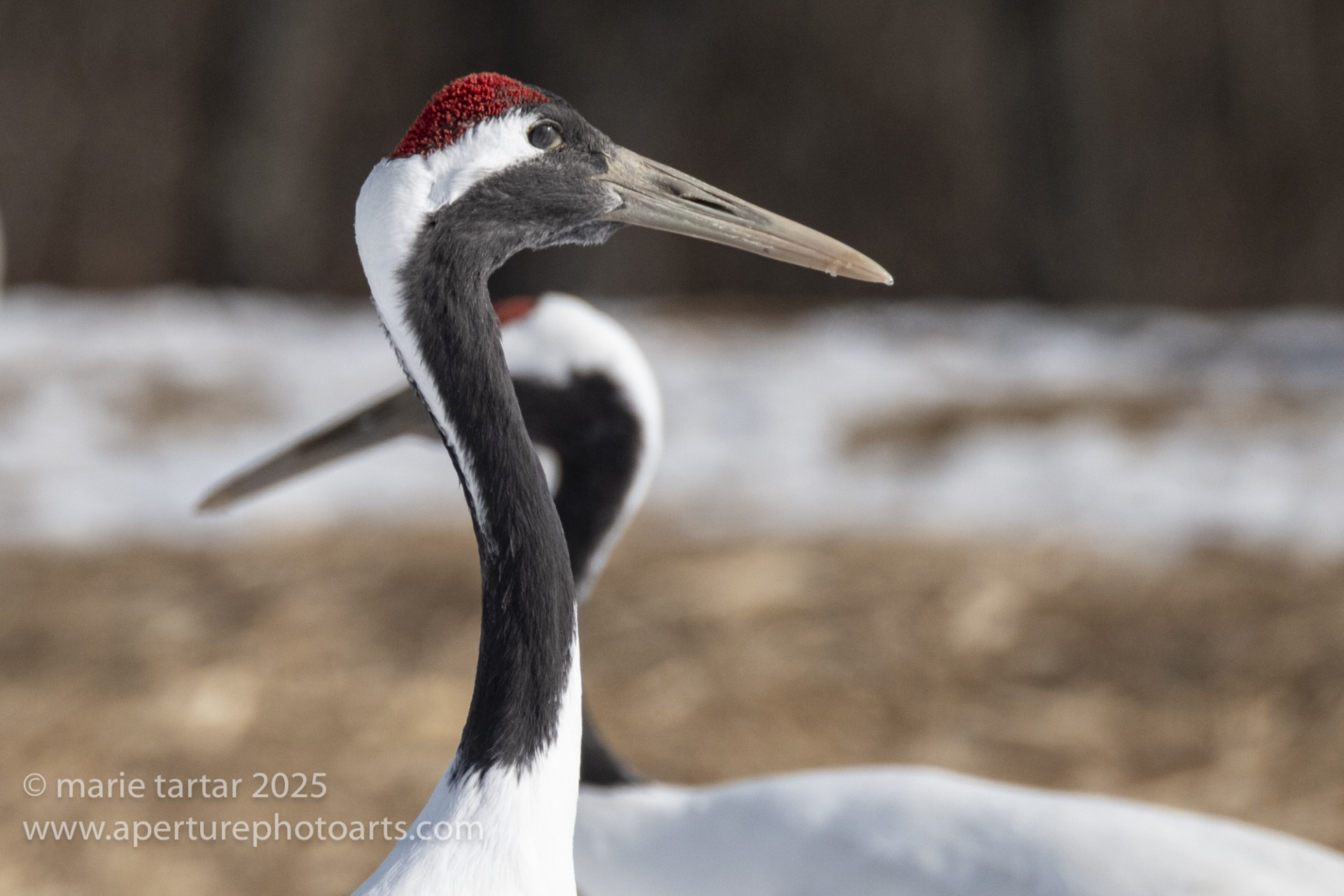
With apologies to TS Eliot: In the fields, the cranes come and go, although I doubt they were talking of Michelangelo. (Liberally adapted from The Love Song of J. Alfred Prufrock)
After three wonderful days with cavorting snow monkeys, in and out of steaming hot springs, with and without snow, we were off to northern Japan, the island of Hokkaido, home to red-crowned cranes, whooper swans and two types of sea eagles, white-tailed and Steller’s.
Already this trip had outstripped by a wide margin our prior “introductory” Japan wildlife trip in 2018. Not only was this itinerary better organized to suit the serious nature photographer (with enough margin built in to allow for the vagaries of weather), the accommodations and cuisine were well selected, comfortable and delicious. Not once did Greg or Steve have to go out to dinner AFTER the evening meal!
Saturday, February 1, 2025
No photography trip is complete without early morning starts, usually in the dark. Today was no exception, meeting at 5:45 am for the short walk from the Excel Hotel at Haneda airport to check-in for our group Air Do flight to Kushiro. The airline gave RC a hard time at the boarding gate about his oxygen device. We’d been advised to pack with an eye toward a quick change after arriving, in the terminal. Once reunited with our luggage, we dug out additional layers and boarded our new bus, with Mr. Sato at the helm. He proved to be a skilled driver whose abilities would be tested by heavy snowfall in the coming days.
After procuring lunch at 7-11 (onigiri and cucumber salad for me), we headed directly to the Akan International Crane Center Tancho Observation Center for the afternoon. Tancho is the Japanese for cranes, which are well represented in symbology and are an ecological success story, as I wrote about in 2018. On that trip, in driving snow, we had only one morning with the red-crowned cranes at Itoh Crane Sanctuary.
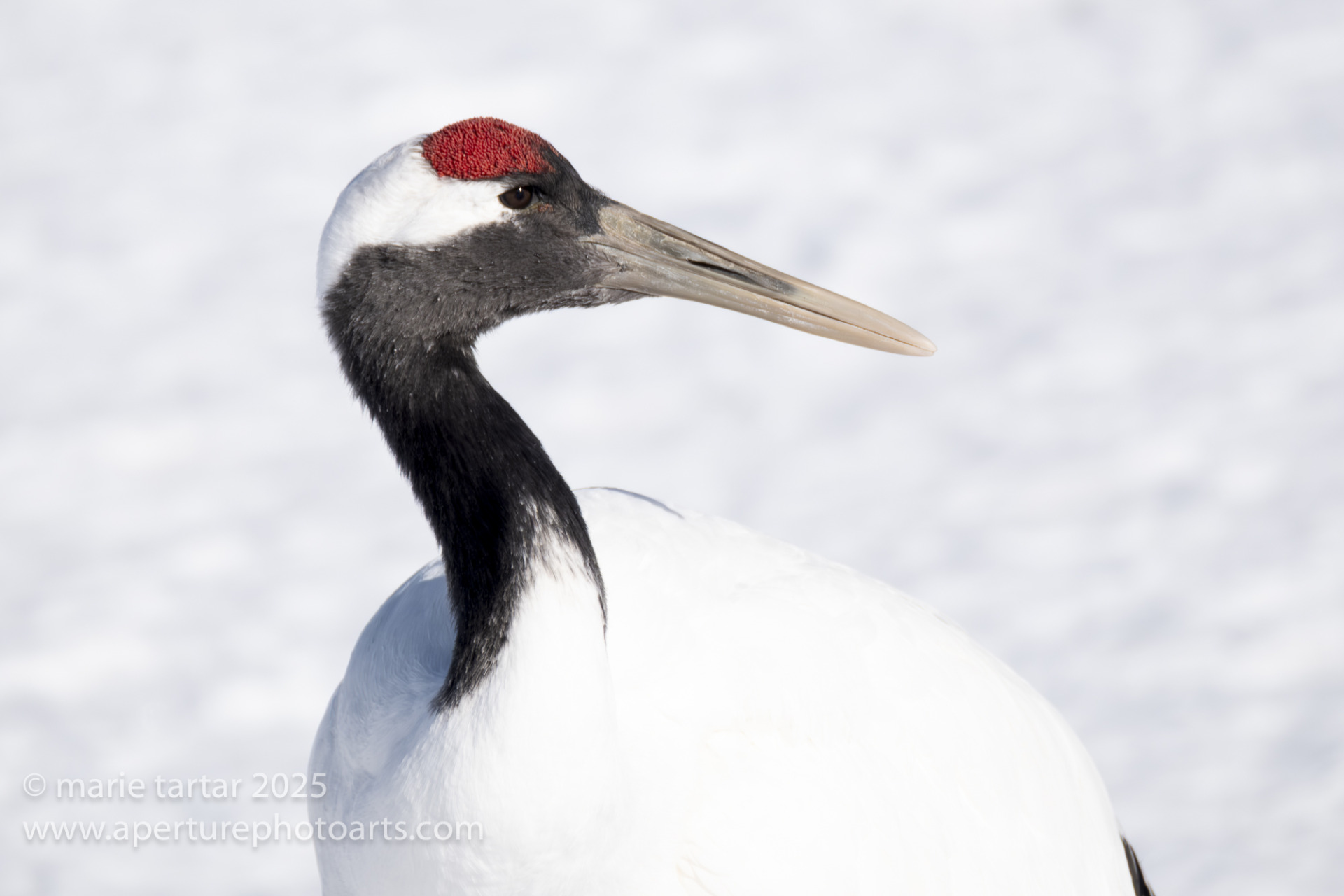
A beautiful bird, Grus japonensis is renowned as a symbol of fidelity (mating for life) and longevity (life span averaging 30 years in the wild and 50 years in captivity). The red-crowned crane sports a cap of specialized red skin.
My crampons barely fit over my Pajar boots, which have built-in, reversible, mini spikes. Arriving after the others at the visitor’s center, just about to exit out the back of the building, Steve warned me to be careful-there had already been a couple of slips and Lloyd had gone down hard. He is tall and hardy-appearing, so I was reassured to see him afterwards at the raised, more distant crane viewing area. He had his camera, so I assumed he hadn’t sustained any major injury. I was surprised to hear later he had slipped off an icy step, striking his right chest on the edge of a concrete step. Later, after becoming pale and shaky, Yukiko accompanied him to a clinic, with his wife Angela, where a chest x-ray diagnosed 5 rib fractures! I broke a rib once, being swept by a wave into the boat I had just exited and could only imagine how much pain 5 fractures would engender.
Benito apparently was a near-casualty as well, slipping at the same place. He was lucky to be steadied by Steve and Angela. I crept around gingerly, little old lady-style, the memory of my slip and fall on ice on our prior trip to Hokkaido fresh in my mind, resulting in an ankle sprain which had me hobbling the rest of that trip.
The snow coverage was patchy, with large expanses of straw-colored grass visible.

Red-crowned cranes are fed in the winter in Hokkaido, Japan. (Akan International Crane Center). Their habitat is marshes and wetlands.
These Grus japonensis cranes are extraordinary in myriad ways, attracting admirers and photographers from around the world. For starters, they are huge, standing around 5 feet tall, with a wingspan on the order of 8 feet!
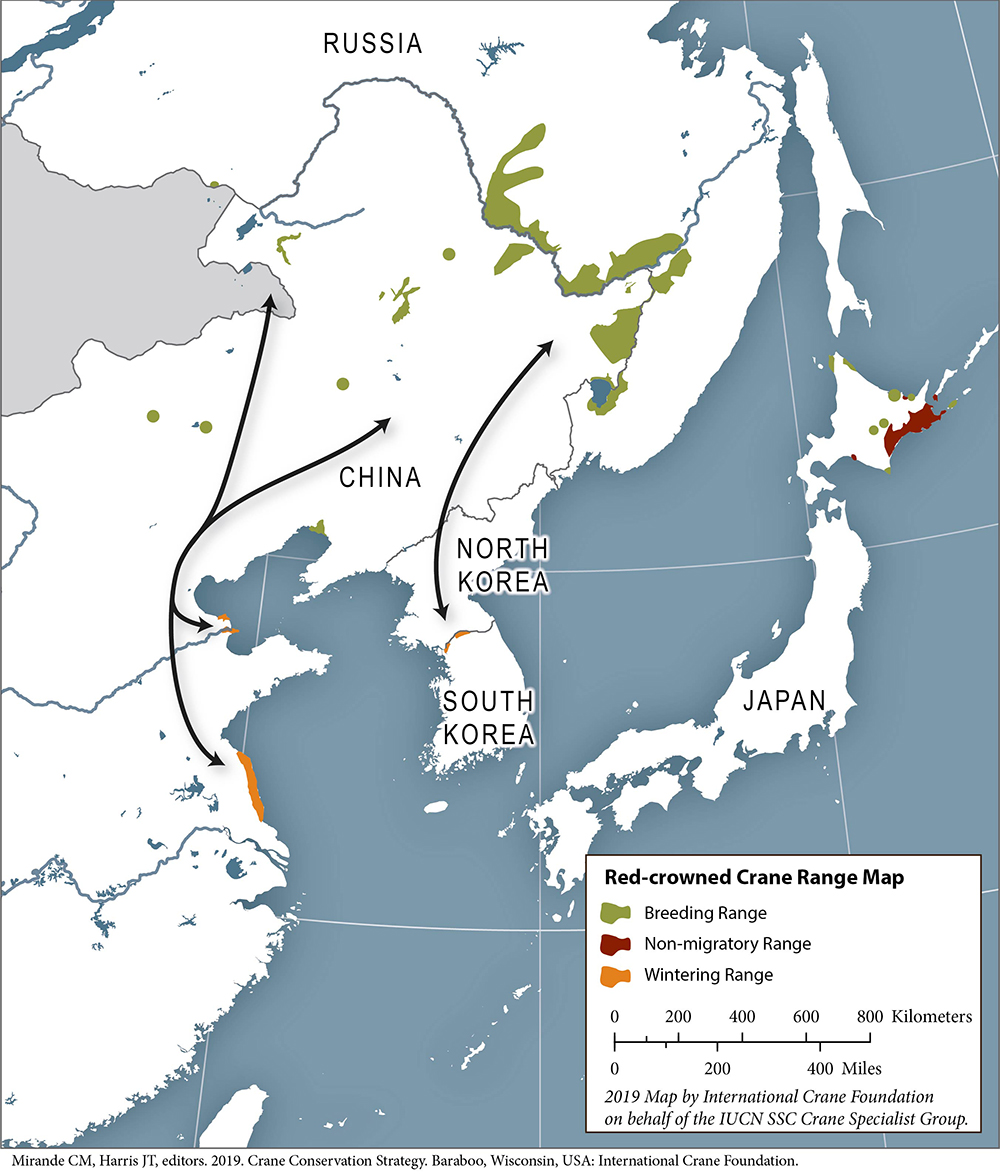
The population in Hokkaido is resident, with migratory groups found in spring and summer in Siberia and northeast China and Mongolia, shuttling south in fall to central China and Korea.
They nearly went extinct before rebounding in the second half of the 20th century, with farmers and local residents putting out food for them in the winter. They were designated a National Monument by the Japanese government in 1935. When we saw them in 2018, the Japanese population was estimated at 1500, about half the world population. By 2021, the Japanese population was estimated to be 1900. In the same year, the International Union for Conservation of Nature upgraded the red-crowned crane’s status from Endangered to Vulnerable. Now that their numbers are better stabilized, more recent efforts on the bird’s behalf focus on lessening their dependence on winter feeding. This has led to problems, with cranes seeking nourishment on local dairy farms. This dynamic is well covered in this New York Times article, which includes a quote from Wada-san, who we would meet on this trip.
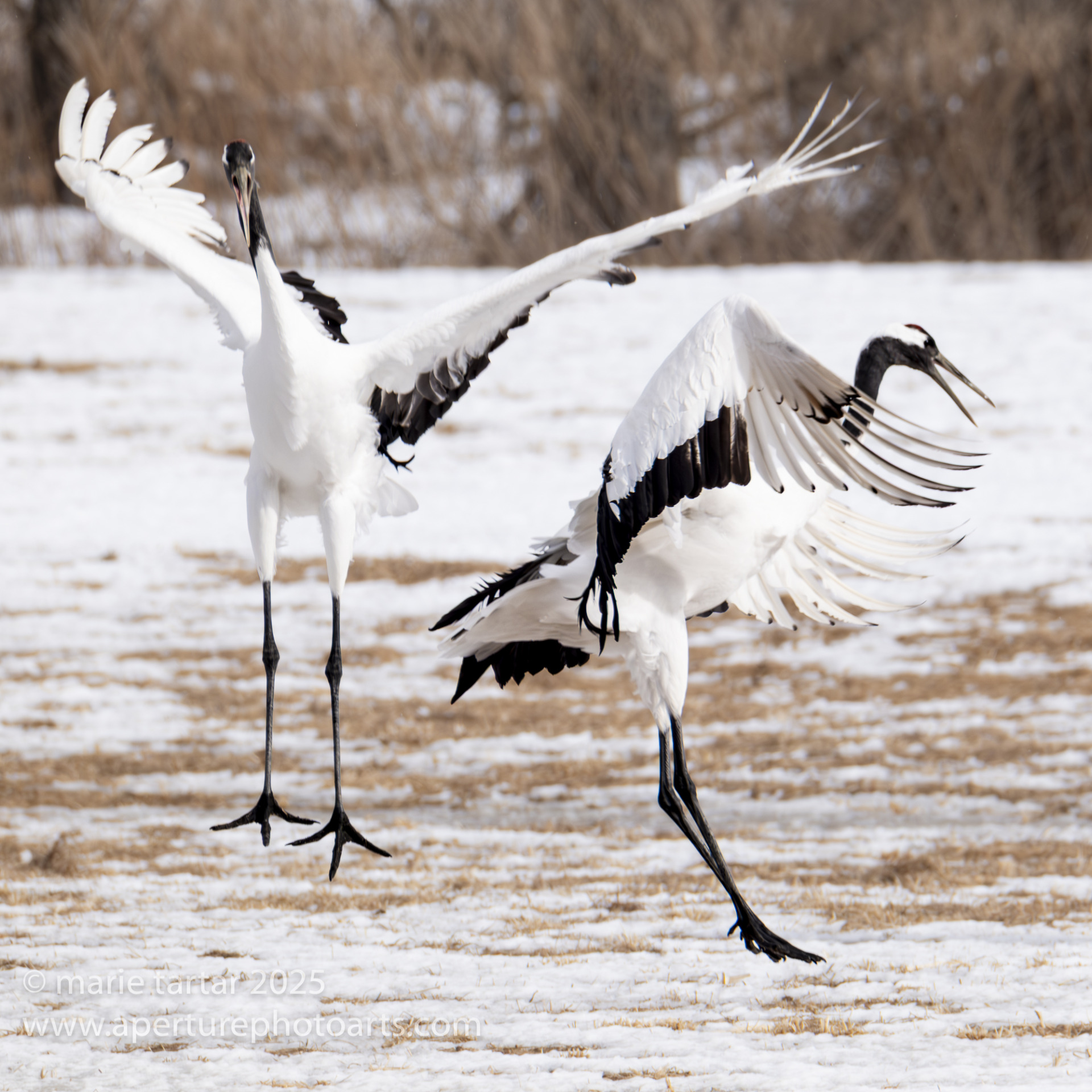
It’s hard not to interpret the interactions of red-crowned cranes as delight in seeing each other (Hokkaido, Japan).
Martin had more in store for us to round out this day. The bus pulled over and down a snowy track was a sleeping Ural owl.
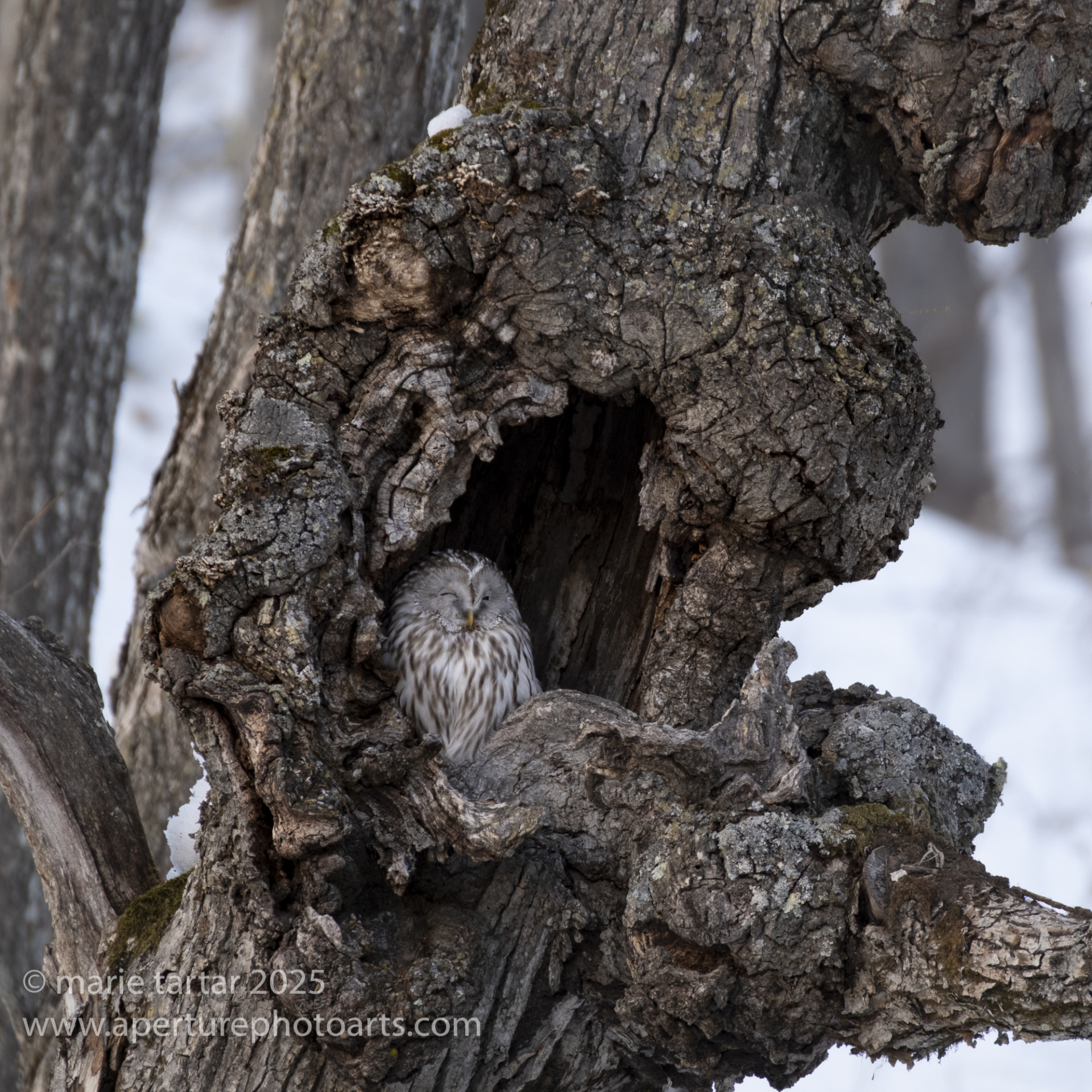
Sleeping Ural owl, worth a trek down a snowy path. I used all the glass I brought (100-400 mm lens at 400 mm, plus a 1.4X teleconverter), but wished I had brought the 2X.
Fearing my mini-spikes might not be adequate for a potentially slippery walk, I struggled to maneuver my pull-on crampons over my Pajar boots. This proved to be near impossible, at least to do quickly. Deji lent a helping hand, after I succeeded in donning one, only to have my glove fingers trapped under the rubber binding.
This same crampon issue also delayed my arrival at our final crane shooting location in a park. Just when I had them on, the group was turning back, the cranes having flown out en masse.
Sunday, February 2, 2025
We rose in the dark again for a 5:15 am departure for the Otowa Bridge near Tsurui Village. Martin had warned us that unscrupulous groups of photographers from a large Asian country (from which he no longer accepts guests) coerce their bus drivers to take them there in the middle of the night so that they can plant their tripods to claim spots for the sunrise shoot and woe to anyone who tries to usurp their positions in the line-up. He thinks photographing the cranes in the river bed is warranted only when hoarfrost coats the trees. Hoarfrost requires particular combinations of low temperatures and humidity to coincide and he estimated our chances of having the necessary conditions at 80%. Without hoarfrost, he was disinclined to jostle for position in the line-up. As it was, he warned us we would find the middle of the bridge prime positions already taken, forcing us either to the sides of the line-up or to shoot from a second tier, dodging elbows and shoulders of those in the first row. I chose to stay to the left of the line-up, preferring the curve of the river from that vantage point and preferring not to dodge body parts. I was reminded of another sunrise at Mesa Arch, in Canyonlands, another confined space in which hoards of photographers vie for position with middle-of-the-night arrivals.

Before sunrise at Otowa Bridge, hoping for hoarfrost (which never materialized). The cranes were distant and the scene was essentially monochromatic. The barest pink tinge dappled the water for a few minutes.
The hoarfrost never materialized. Sara and Robin looked cozy and rested at breakfast on our return. Angela and Lloyd stayed at the hotel for the day.
The rest of us spent all day back at the Akan International Crane Center.

The snow coverage was still sub-optimal on day 2 of our red-crowned crane shoots, but we did have some intermittent sun to warm the scene. (Akan Crane Center panorama, Hokkaido, Japan)
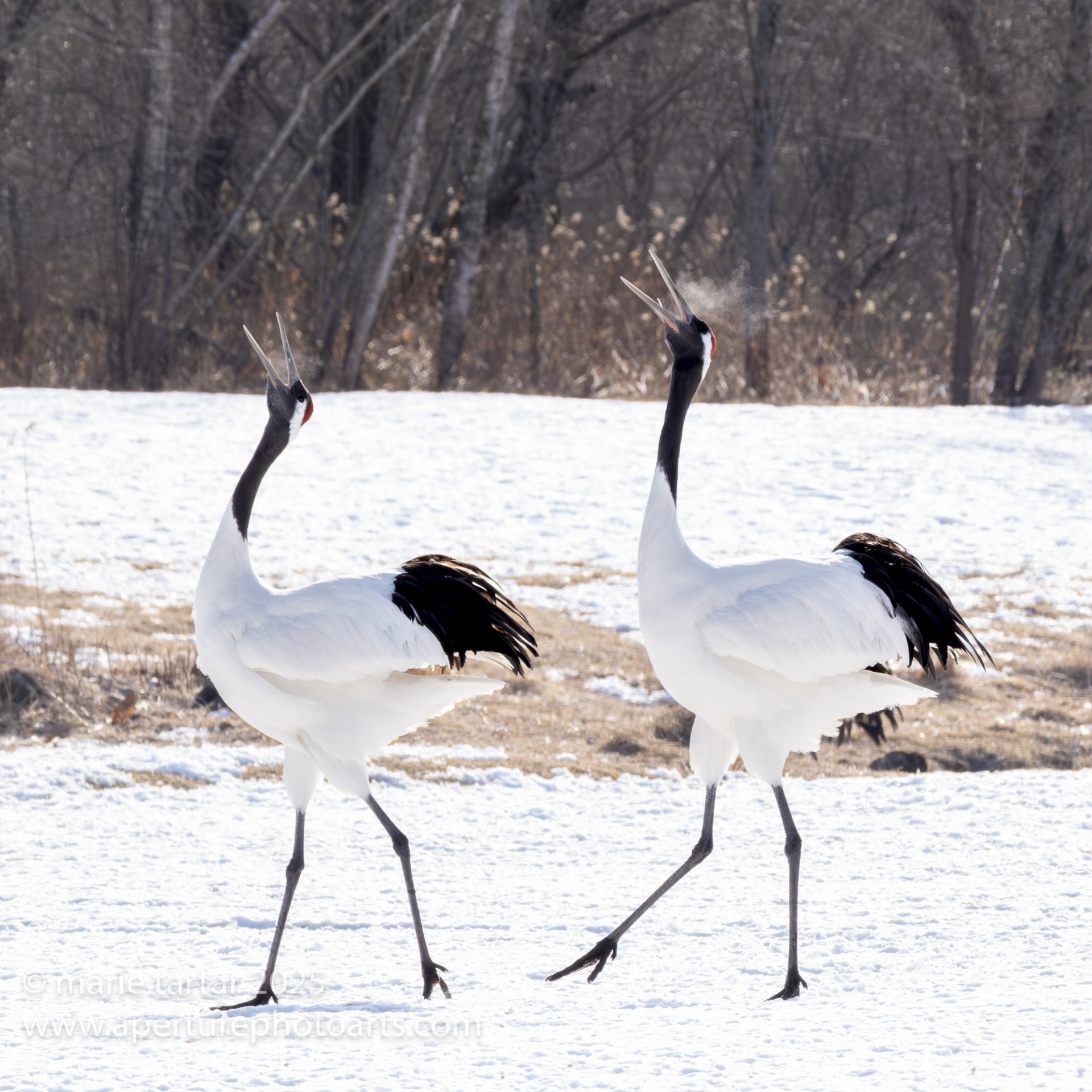
Red-crowned cranes calling each other, their breath visible in the cold (Hokkaido, Japan). Calling in unison is thought to strengthen the pair bond of these cranes, who mate for life.
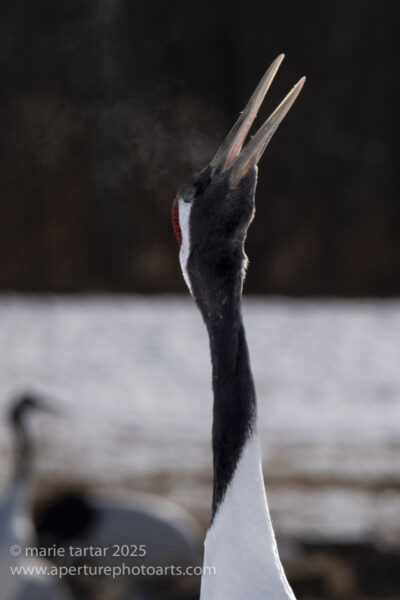
Red-crowned cranes throw back their heads to call to each other. It was cold enough in the morning to sometimes see their breath, but generally we were well prepared for the temperatures.
The limiting factor for me, as always, was freezing fingers. For this trip, I’d procured heated gloves from a Canadian company, Motion Heat. They are a two-part system, with medium-weight liner gloves threaded with heatable metal. They are supposed to be paired with an outer glove. Our liners arrived barely before our departure. Fortunately, they were the correct size but there was no time to order the outer glove companions. I discovered for myself a sad truth that Greg had already figured out. The heated gloves worked great, except when wet. They also proved colder than regular gloves once the battery was exhausted, thanks to the metal leads down each finger. While my fingers were responsive, I practiced panning as the cranes and some whooper swans flew in and out.
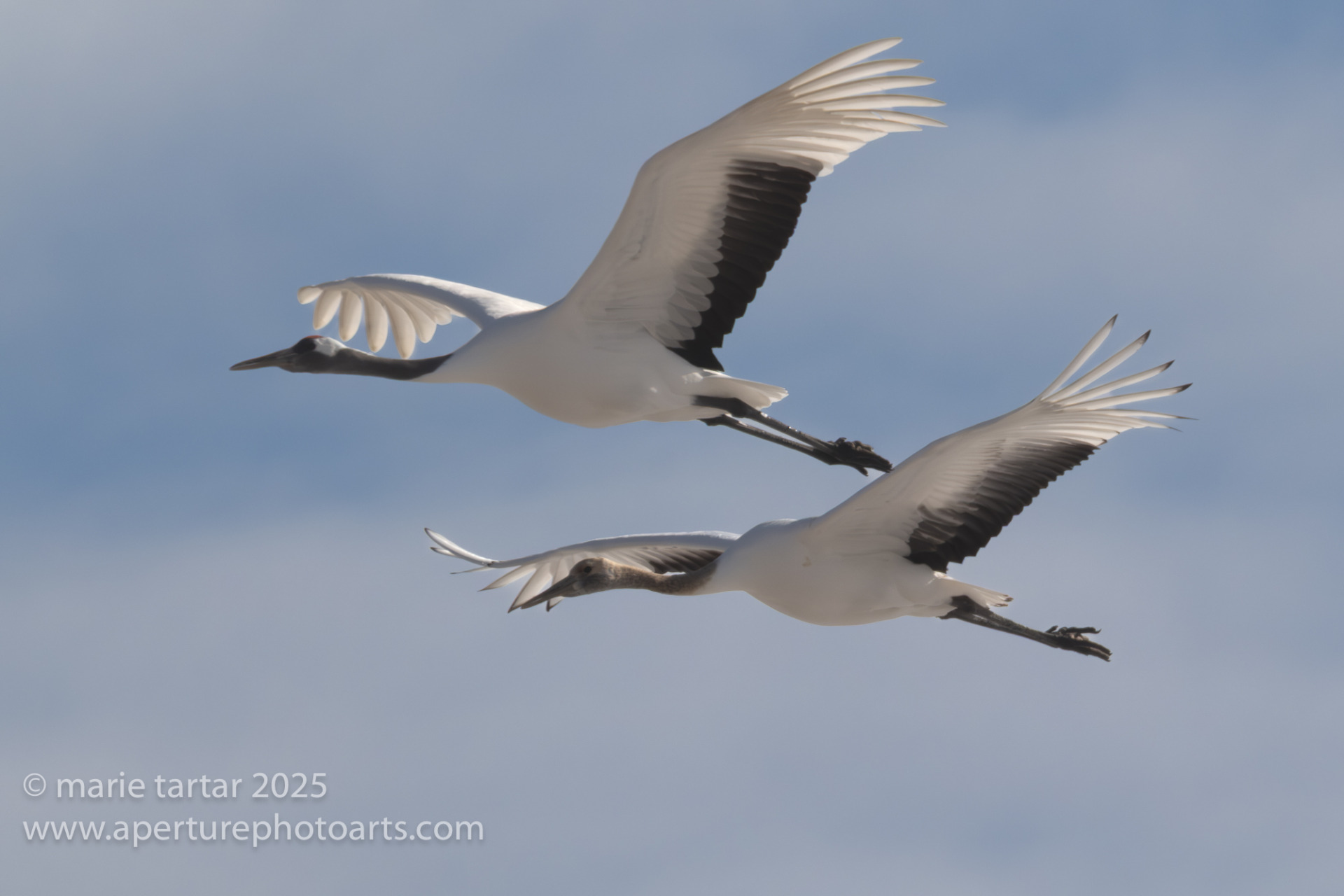
Red-crowned cranes in flight in Hokkaido, Japan: While my rig (Fujifilm XT-5) isn’t considered the very best for bird photography (birds in flight being the toughest measure), I had some success after our first day with the cranes, after realizing I didn’t have the continuous tracking setting on.
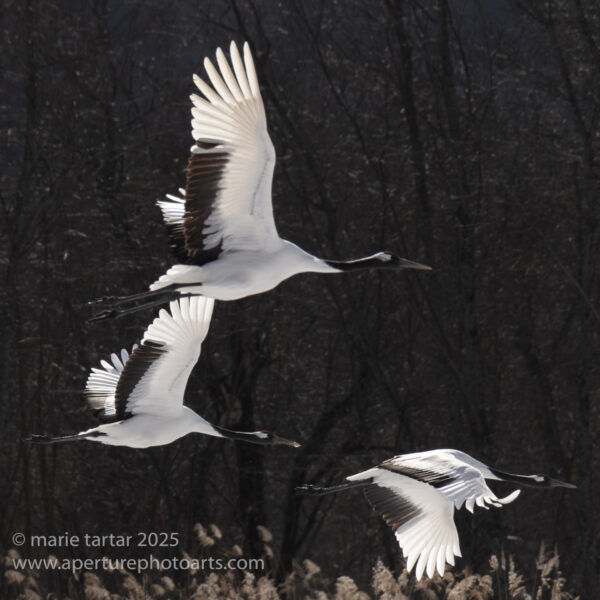
An impressive squadron of red-crowned cranes, flying in formation to a winter feeding ground, Hokkaido, Japan.
The trees out front, in the carpark, provided an alternate shooting location, not for cranes, but for tits, including the small and attractive but elusive white-tailed tit.
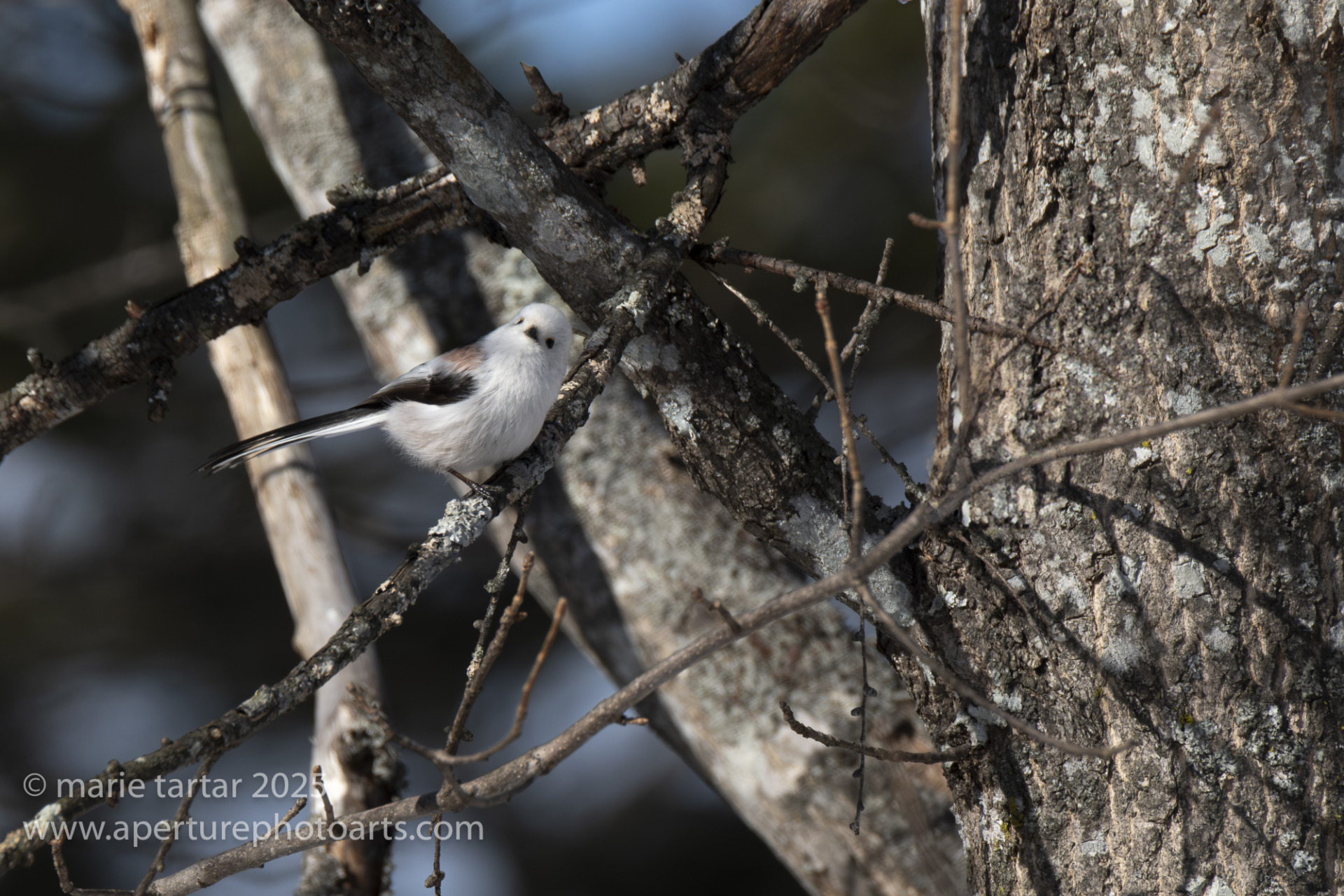
Hokkaido’s “snow fairy”, a sub-species of long-tailed tit, had become an unofficial mascot, judging by the number and variety of souvenirs featuring this tiny bird. Nothing like a tiny, flighty bird requiring a long lens trained up into the treetops to try one’s patience!
We stopped back at the hotel before heading out for our final shoot of the day, the same park where we’d ended our shooting the prior day, hoping for a crane fly-out.
Steve decided to bag the final crane shoot. He told me and I assumed he’d notified either Martin or Yukiko. Apparently, this wasn’t so:
Martin “Is Steve coming?”
Me: “No.”
Martin: “He should have told us.”
Communication…it’s everything!
Back at the hotel, I plunged into the Hotel Taito’s onsen, notable for reddish-brown tannic water. A screaming toddler being scrubbed vigorously by his mother rent the peace of my soak.
Monday, February 3, 2025
We left this morning for Lake Kussharo, which unlike our prior trip, did not freeze this year. Before departing Hotel Taito, Martin arranged with owner Masahiro Wada to open his next-door gallery and bicycle repair shop early for us.
Walking over next door, Steve spied what he initially thought was a squirrel figurine. It was an adorable Hokkaido squirrel, feeding on a pine cone outside the gallery.
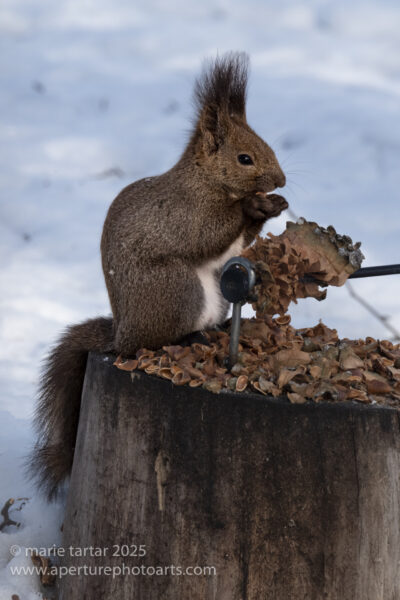
The perfect set-up to attract the adorable Hokkaido squirrel in winter: a pine cone on a rotating spit.
On our transfer to Kinkiyu Hotel in Kawayu Onsen, we made a stop at a stunningly beautiful overlook of the Lake Mashu caldera, which was new to us.
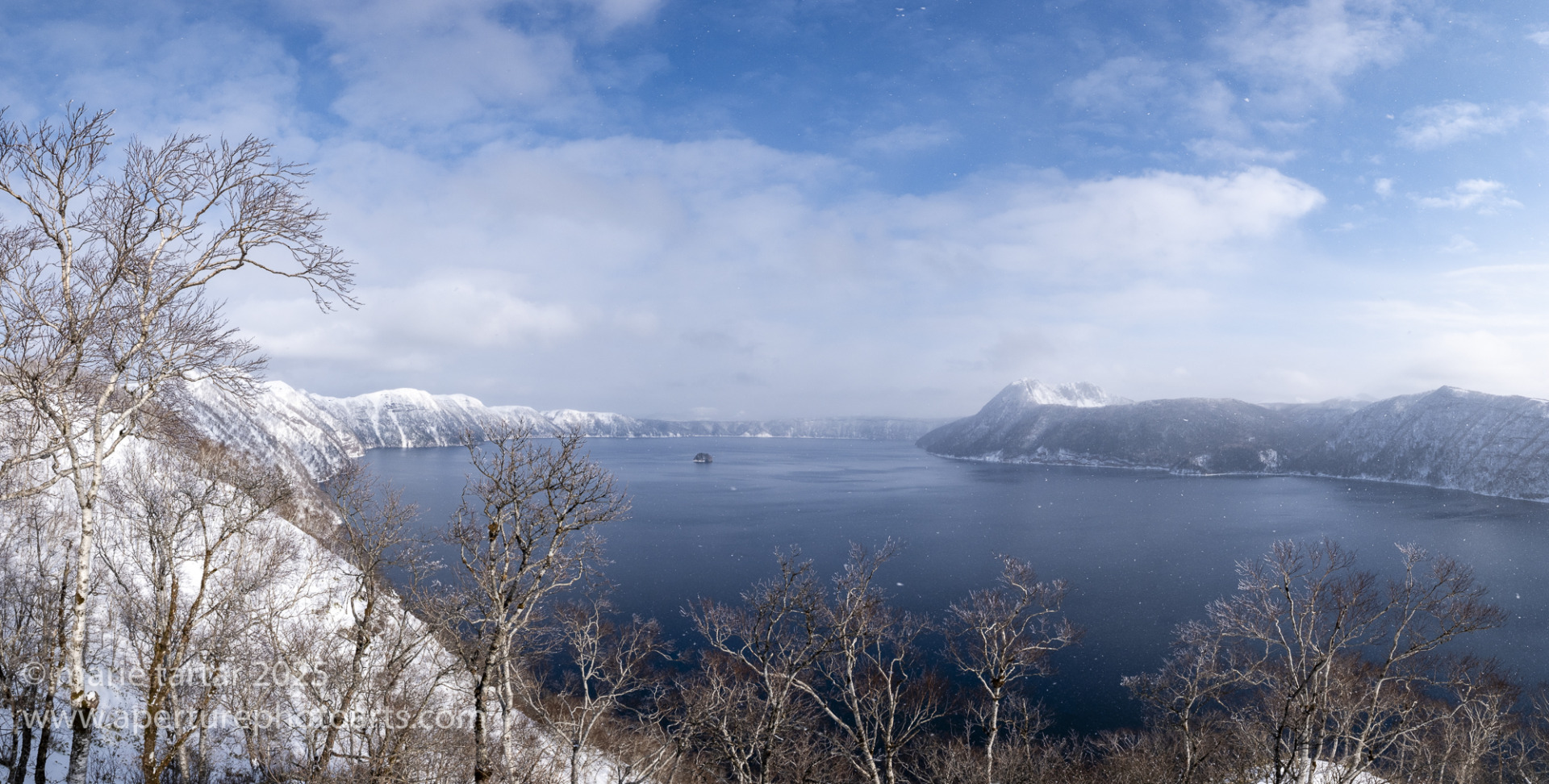
A beautiful winter sight in Hokkaido: Lake Mashu’s snow-rimmed volcanic caldera (Akan-Mashu National Park).
Lloyd made it up to the overlook, armed with a small camera.
We made another stop, also new to us, at billowing Sulpher Mountain (Iouzan), an active volcano.
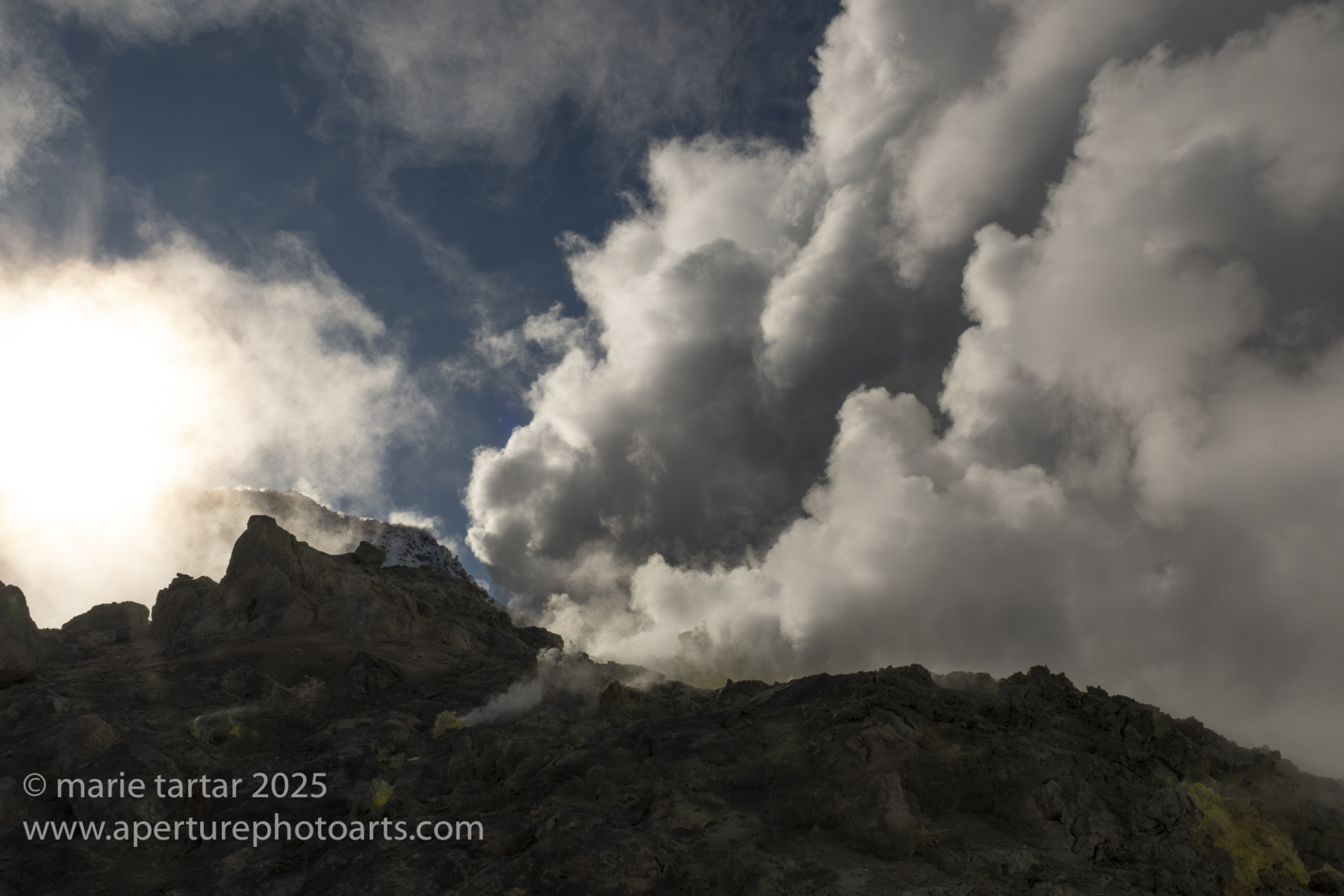
No, those aren’t storm clouds rolling in from above, those are belching sulpherous fumes from an active volcano! Hokkaido, Japan.
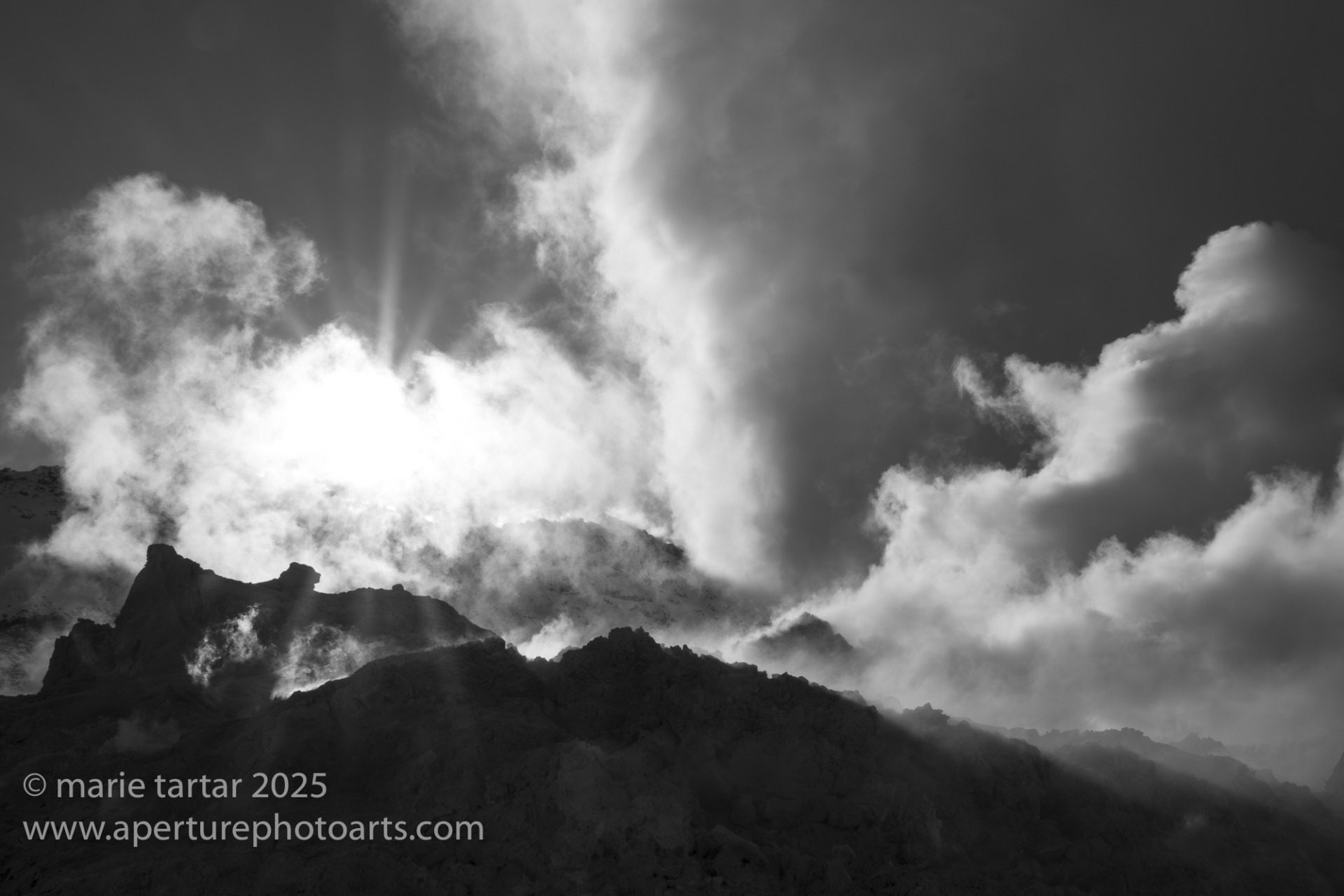
Deciding how to shoot this steamy volcanic scene and then process it was a challenge: color vs. black and white conversion, with or without sunrays?
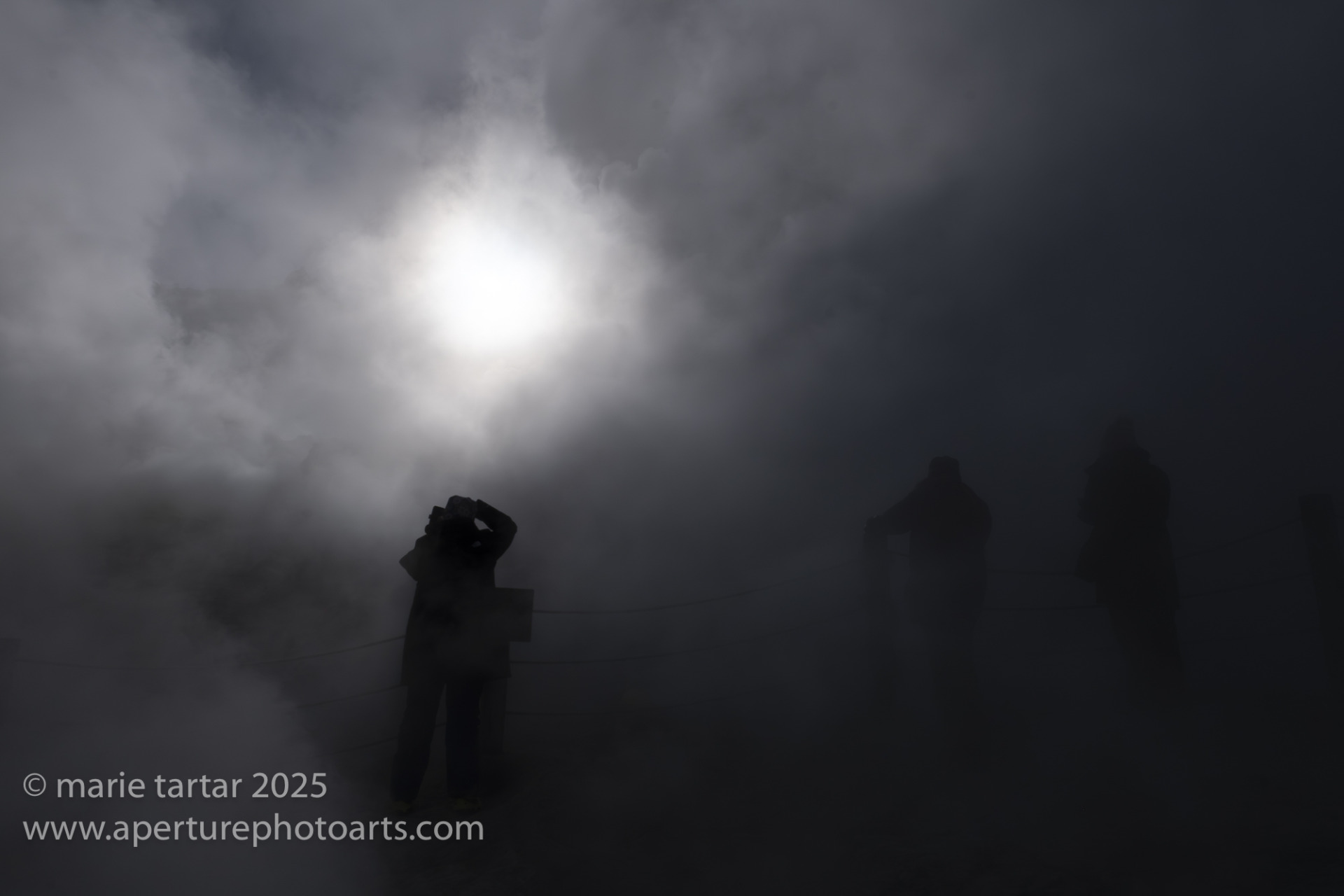
Intrepid photographers (two are disappearing to the right) were not dissuaded by the smell or steam of this volcanic scene.
Although Lake Kussharo was not frozen this year, the swans were still congregated close to the shore, which is geothermally heated. No one availed themselves of the opportunity at Sunayu to dig in the sand at the shore to form their own onsen.
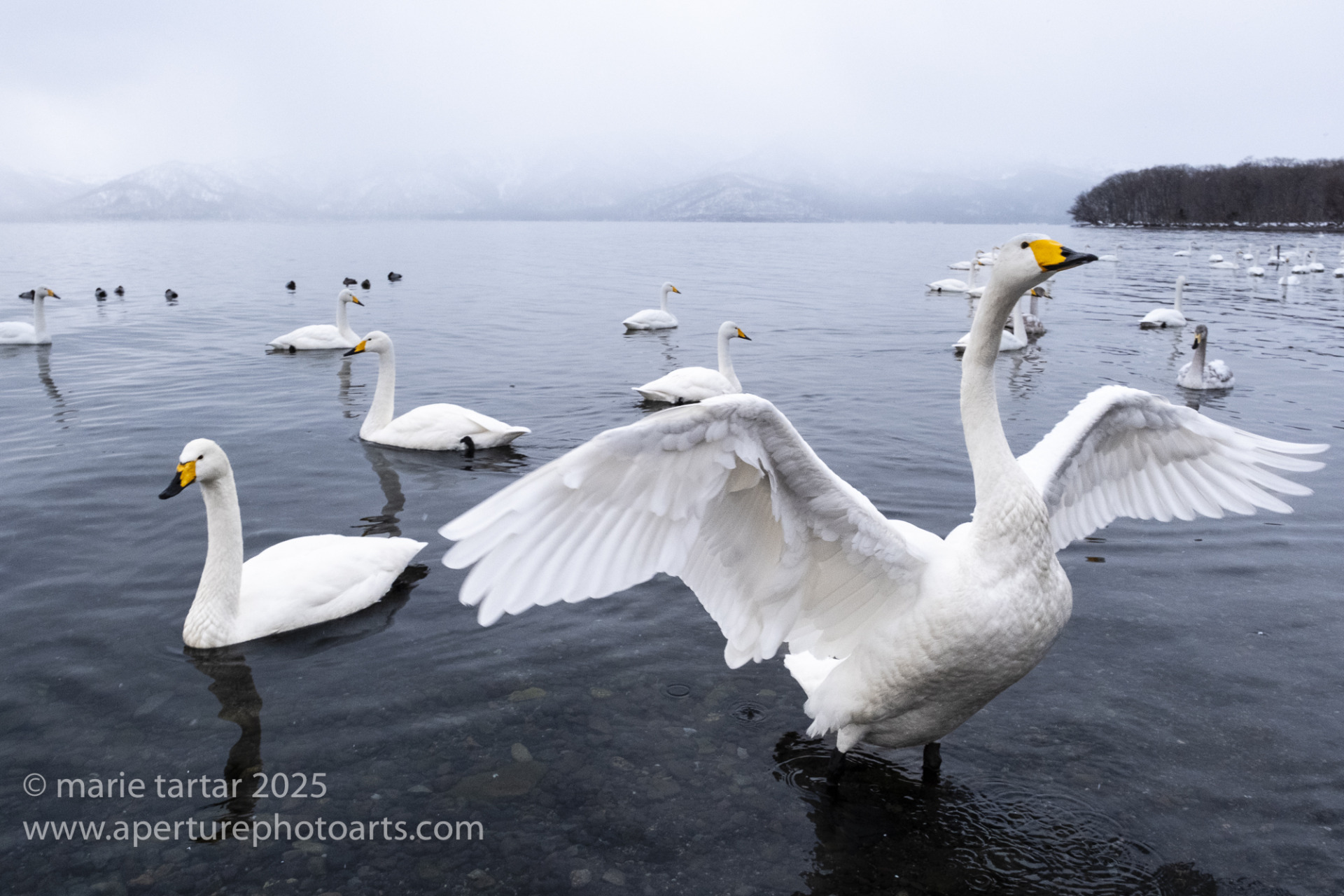
Even though the swans weren’t confined to the shore as in normal winters on Lake Kussharo (when the rest of the lake freezes), the waters near the shores are geo-thermally heated and warmer.
Some swans were also probably drawn in by the unsalted popcorn sold in the gift shop. The swans were close enough I could use a wide angle lens.
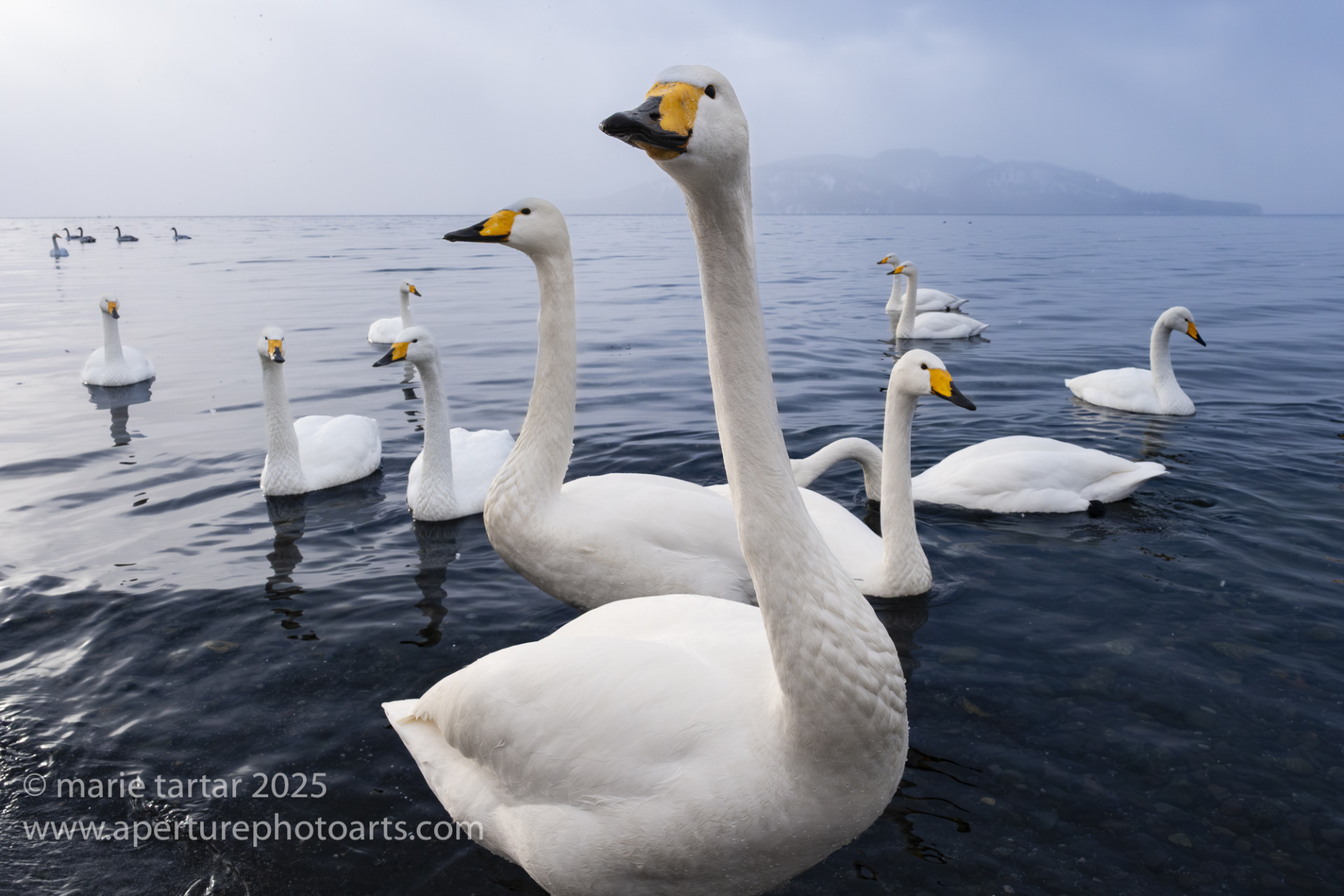
I didn’t wade into the water, the whooper swans were close enough to shore that I could use a 16 mm lens (Lake Kussharo, Hokkaido, Japan).
There were not too many fly-ins, but Steve capitalized on the few opportunities using a slow shutter speed.
Robin found long-tailed tits darting around the trees rimming the carpark across the street.
I was able to have short conversations in Japanese with the wood carving vendors in the shop. One was a total flirt, saying I was cute. I supposed his eyesight was marginal. He offered me a substantial discount on owl carvings (2800 Yen down to 2000 Yen). My Japanese was woefully inadequate to explain that my luggage was already nearly maxed out.
The hotel featured a buffet restaurant with a sushi station. Snow was predicted for the following day, leading Martin to propose returning to the crane center, to which we readily assented.
Tuesday, February 4, 2025
As usual, we managed to be away when the day arrived to schedule our Sedona International Film Festival (SIFF) movies. In the past, I’ve had to work with sketchy Internet connections in Raja Ampat, Indonesia and on Antarctic expedition boats. Coordinating with 10 am Arizona time from another part of the world on another day is always an interesting challenge.
I did not try to wake up at 2 am to schedule our SIFF films. I did awake at 1:30 am but was too tired to stay up for 1/2 hour to get the job done. I did manage it when I awoke again at 3:30 am and was back to slumbering by 4 am. Thankfully, technical improvements over the years meant I had already reviewed the possible choices and earmarked them on an electronic calendar, meaning I just had to put the tickets into our virtual cart and complete the transactions. As pass-holders, we can theoretically see up to 4 films/day over 9 days, but being reviewers, we’ve already seen some of the films and usually like to see 2/day, occasionally 3.
We were admitted to the buffet restaurant early, at 6:50 am, where a line formed immediately for the latte station.
The 5 cm blanket of snow that fell overnight redirected us back to Akan crane center, after briefly scanning Lake Kussharo for swans.
At first, it was snowing so heavily, it was reminiscent of our prior trip, actually hard to clearly see the cranes.
The scrubby grasses were newly and nicely concealed by snow. The cranes were busily feeding and otherwise not very active at first. Towards the end of our stay, there was a sudden burst of activity, with dancing and flying.
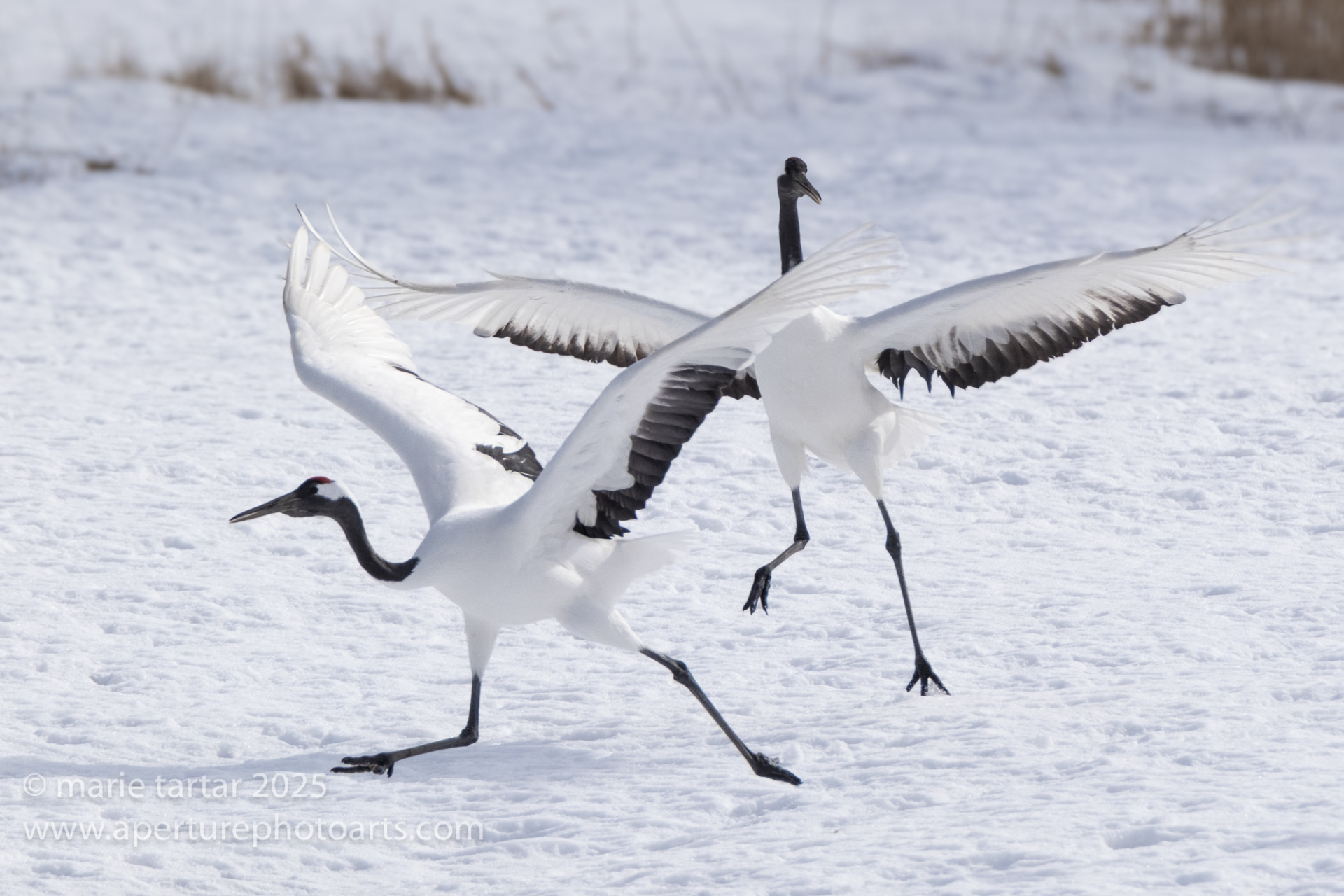
After a quiet interlude in heavy snow, the cranes suddenly burst into spasms of ecstatic dancing in the freshly covered field.
On our drive, a quartet of deer crossed the snow-covered road, with another pair sighted on the ride back.
This snowy day was the perfect end to our stay in crane country. The following day, we were headed further north, to Rausu, on the Shiretoko peninsula. More visual treats and sightings were in store for us: two kinds of sea eagles, fox, waterfalls and more, coming…eventually. A preview:
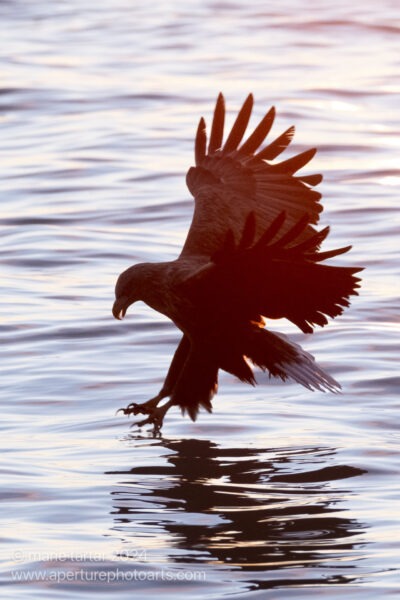
Incoming! White-tailed sea eagle extends talons just before skimming the water and connecting with a fish. Rausu, Hokkaido, Japan.
-Marie

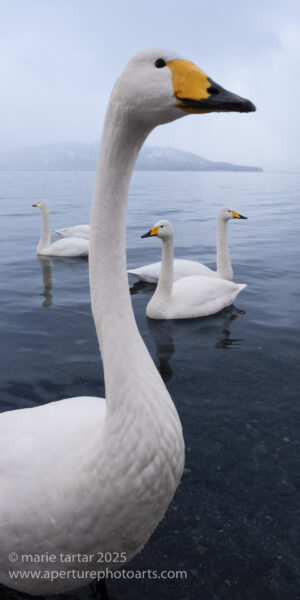
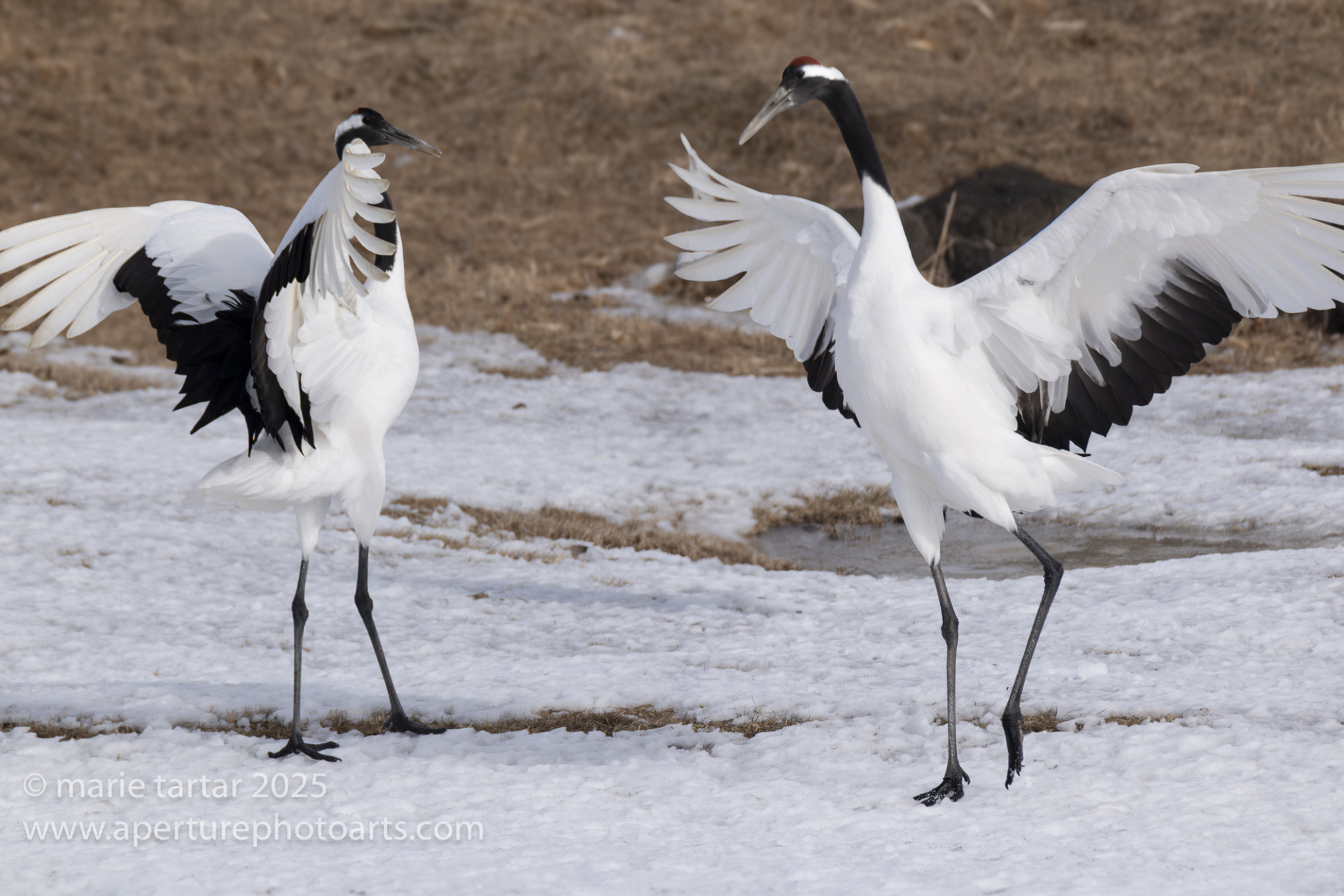
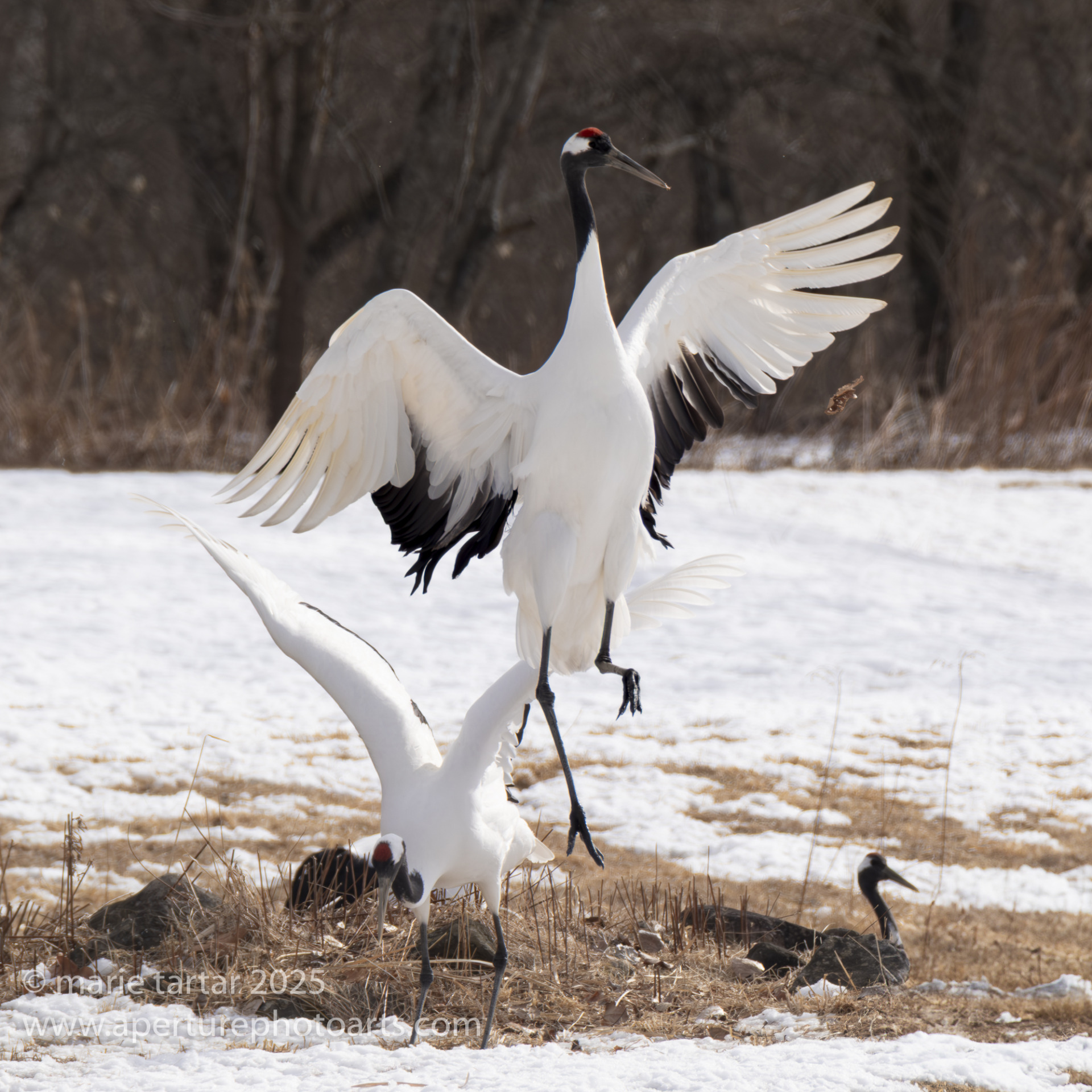
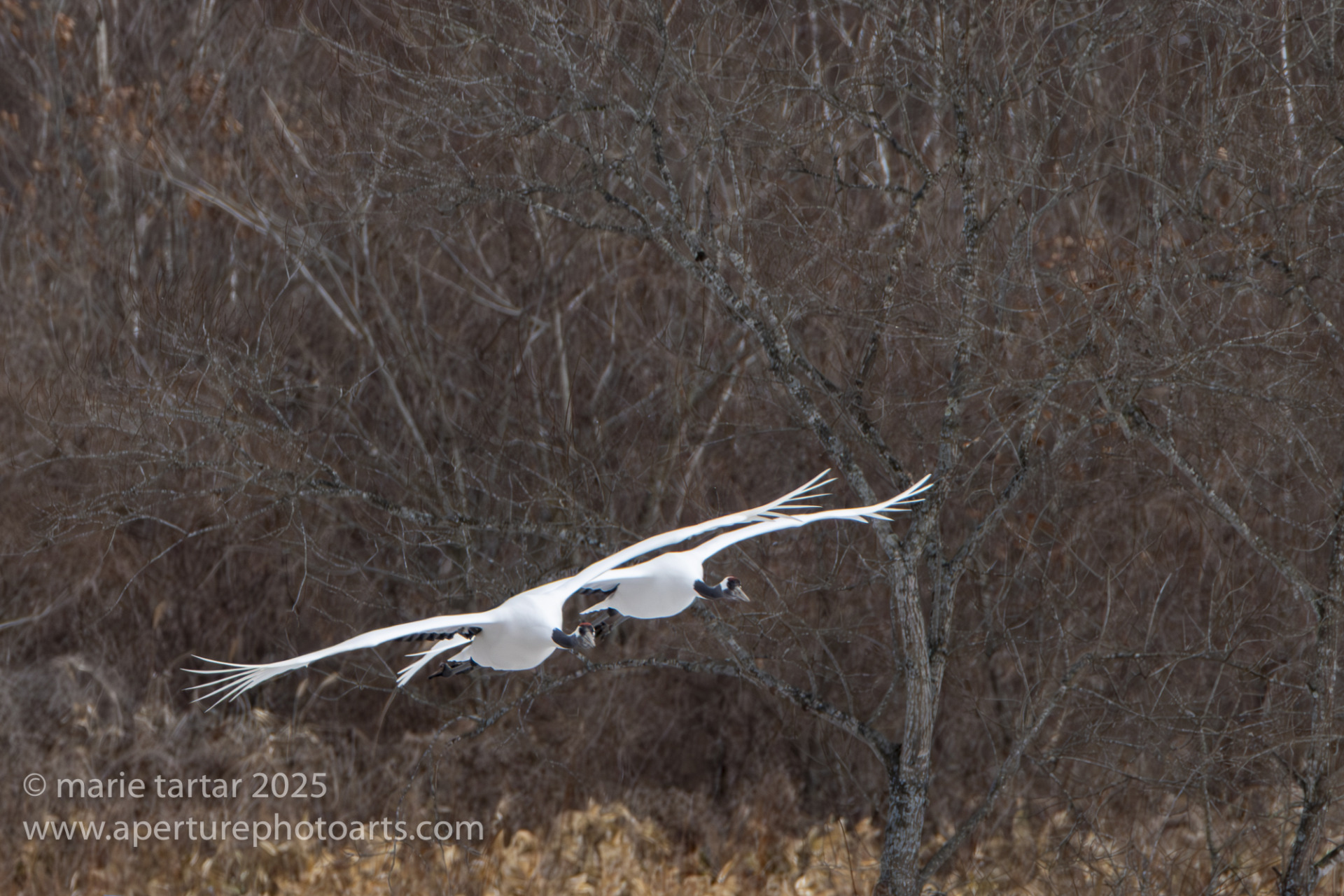
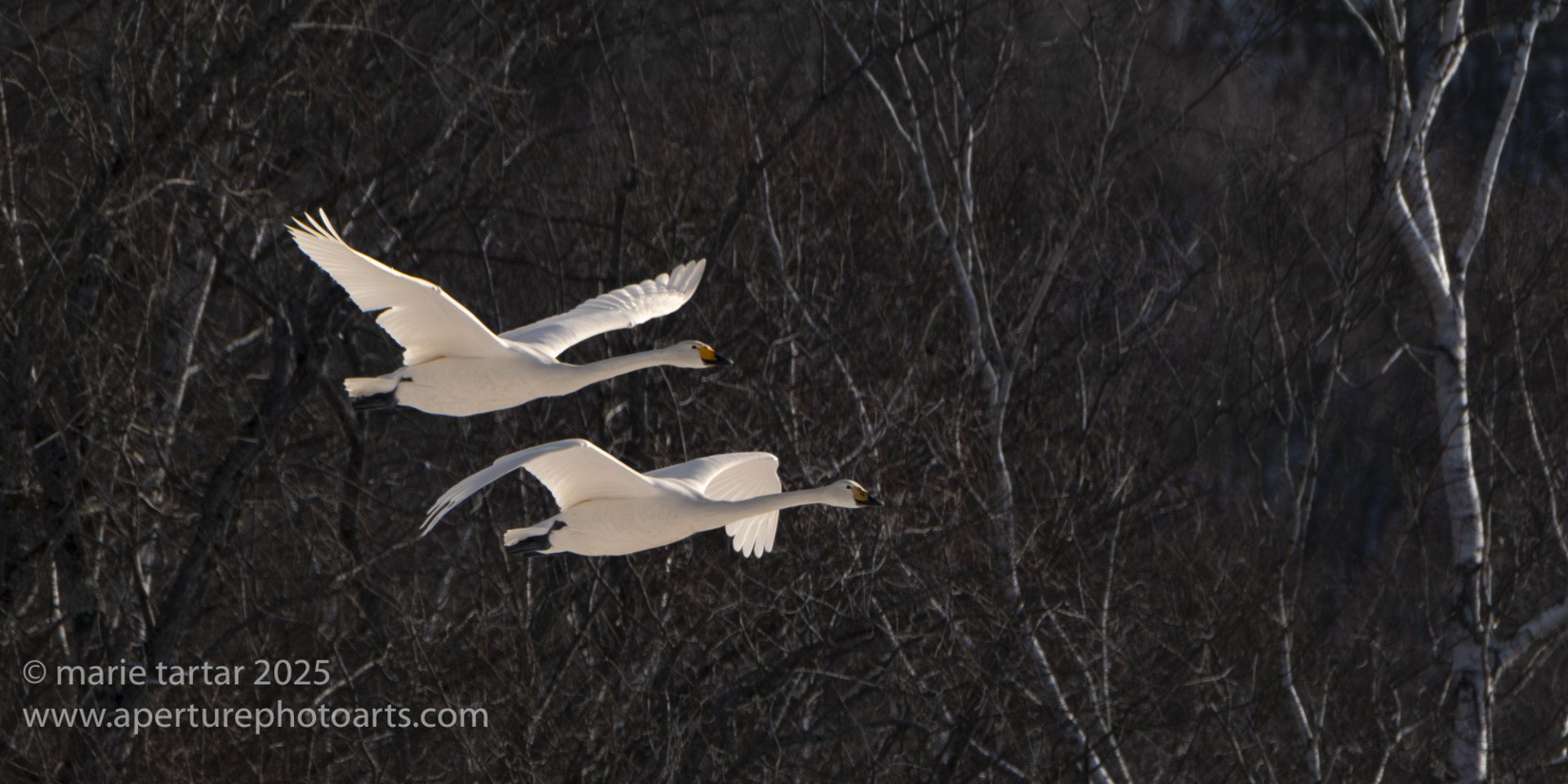
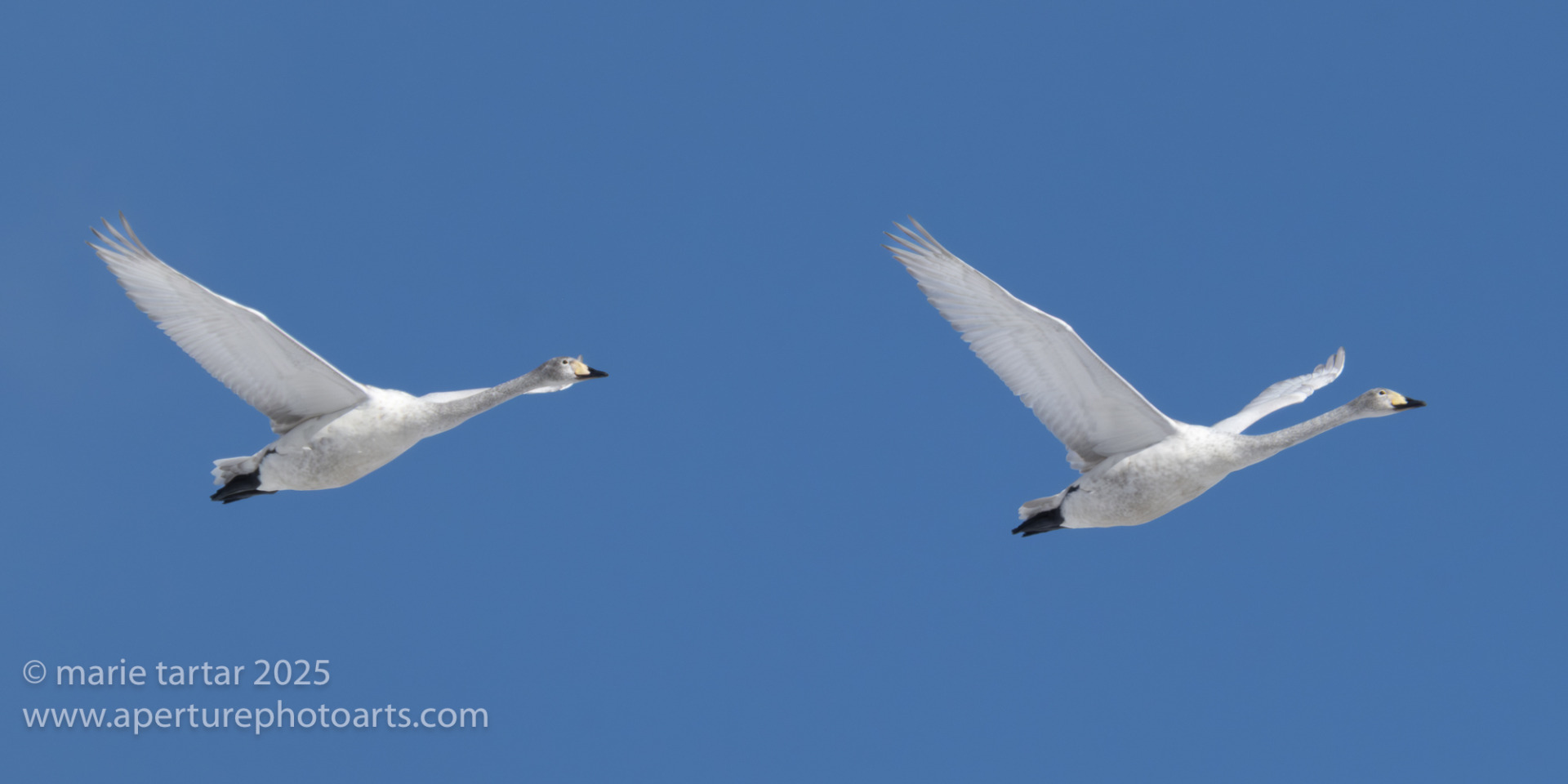

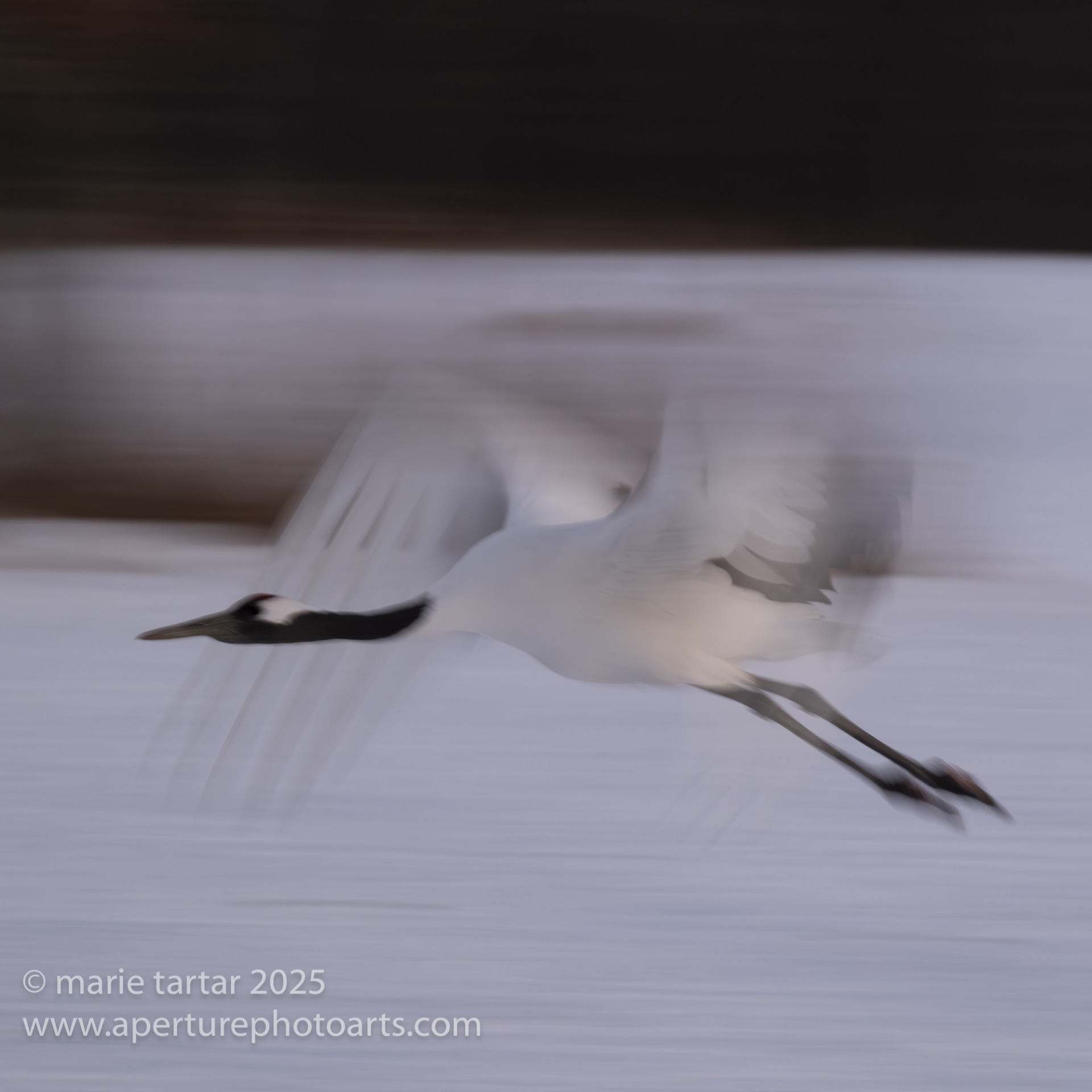
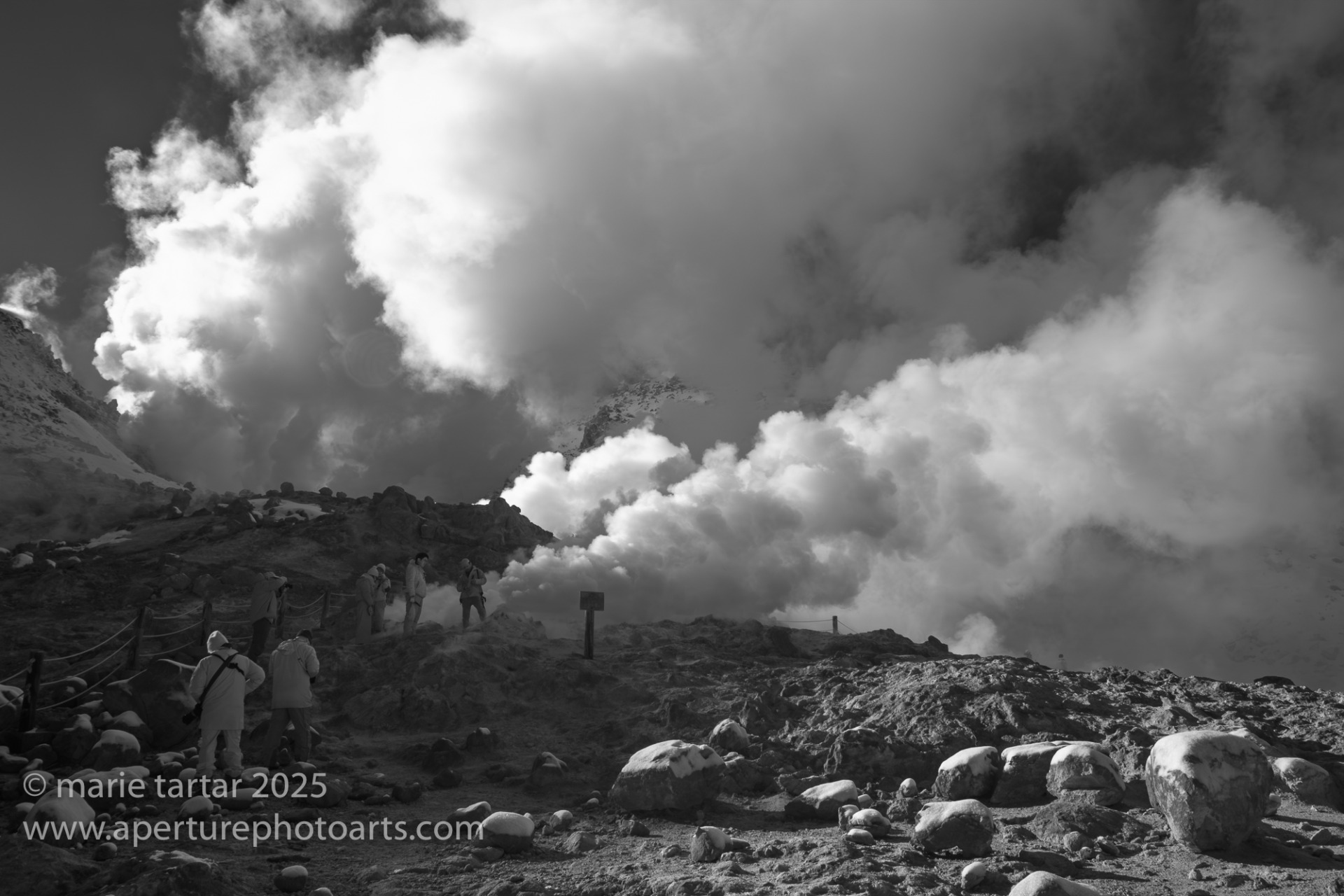
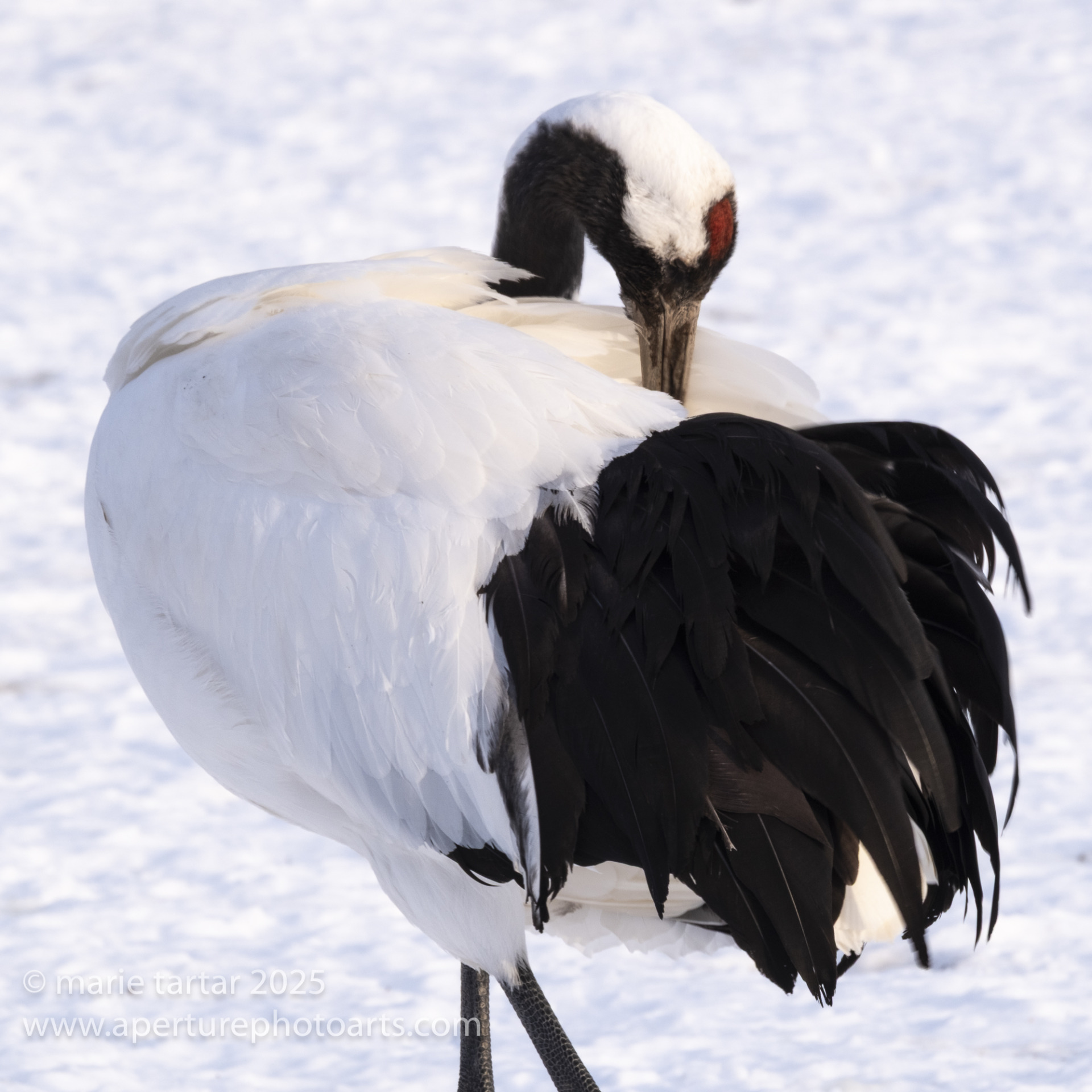
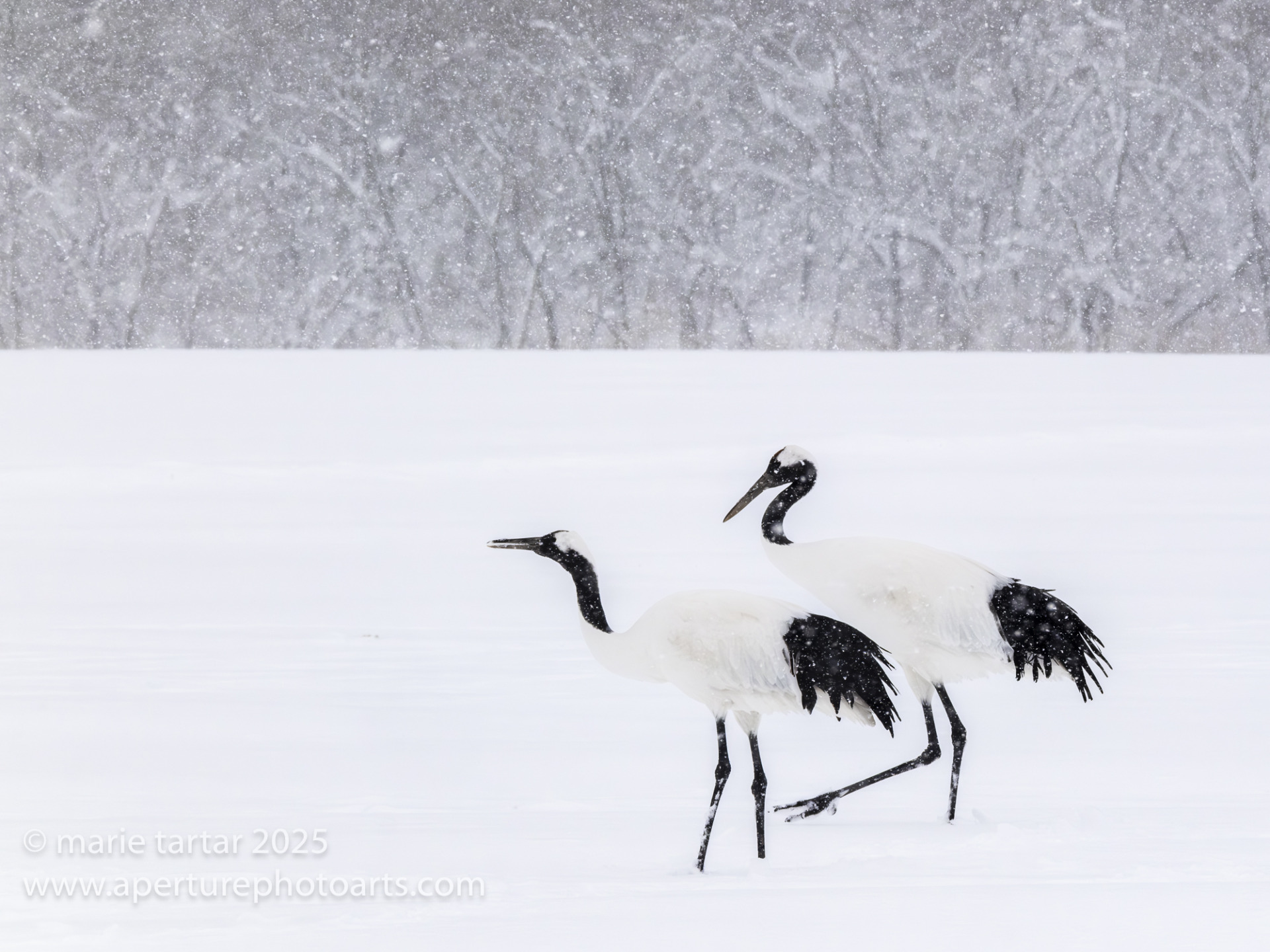
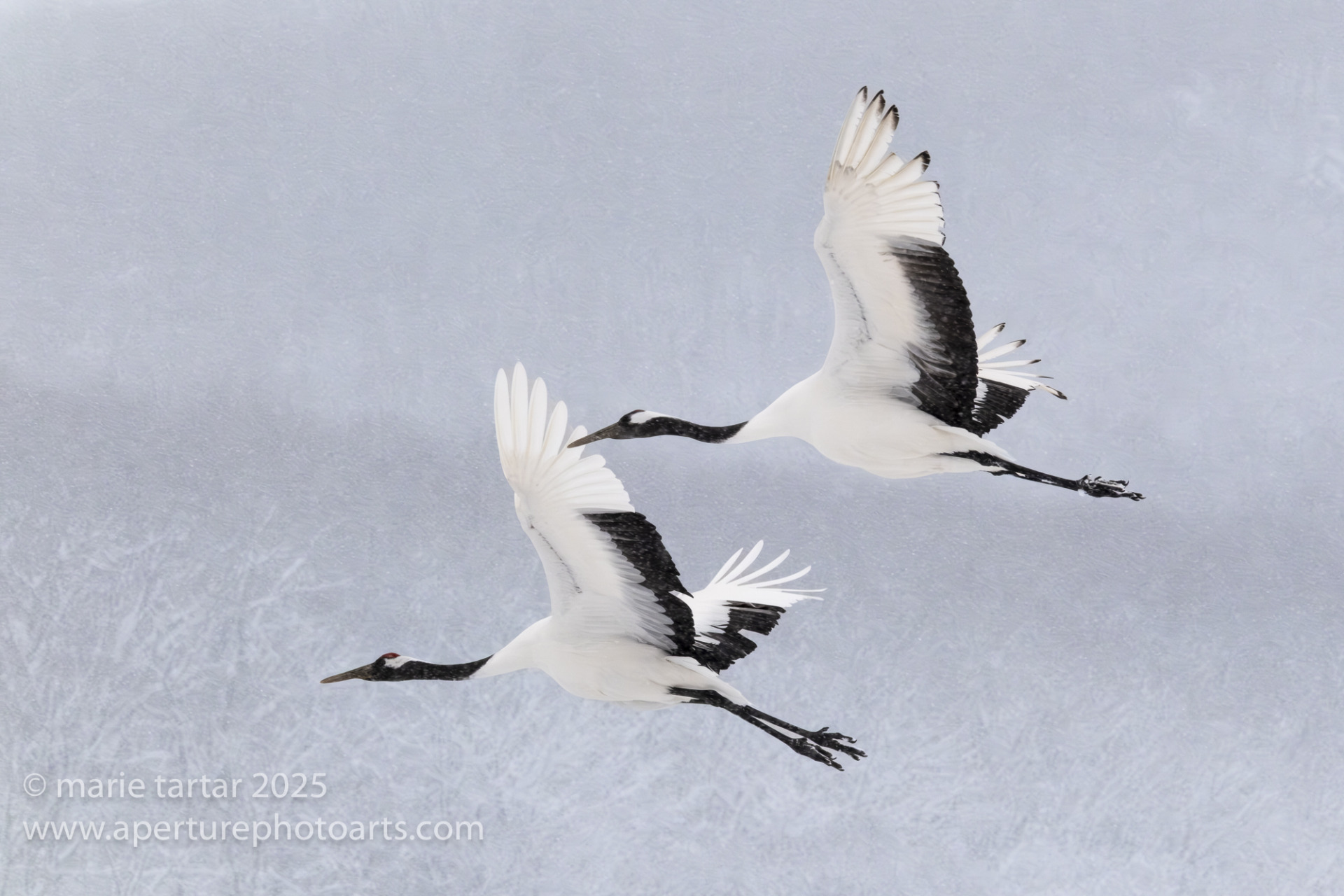

A thoroughly engaging read, Marie. Your recall of dates, places and events is phenomenal. I’m now using your blog as a resource as I try to create stories and posts for my SM. It’s also been an excellent reference for keywording photos in my Lightroom catalogue.
Thank you!
And your photos were fine too. I’m astonished that you got decent shots at Otowa Bridge. Your calling cranes were gorgeous!
Enjoy the Philippines!
Deji
Thanks Deji, It was a pleasure traveling with you!
-Marie
Incredible photos, your commentary wonderful, I feel like I was with you!
Steph, you are my most faithful virtual travel companion!
xoxo,
-Marie
Incredible! The photography & narrative makes me feel like I’m with you, thanks for sharing